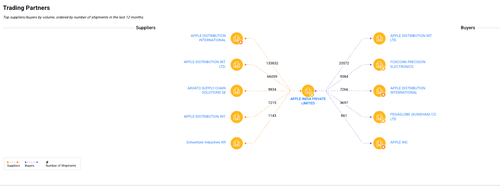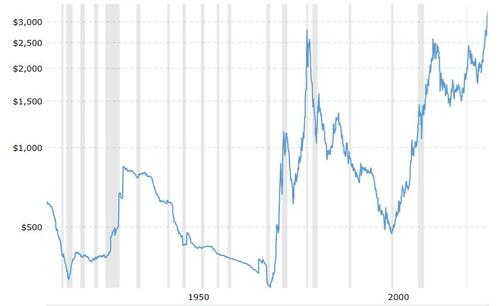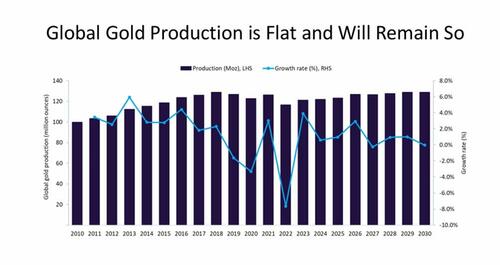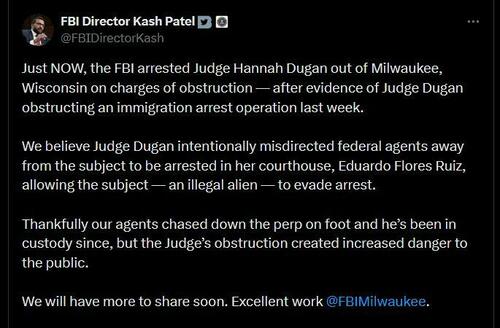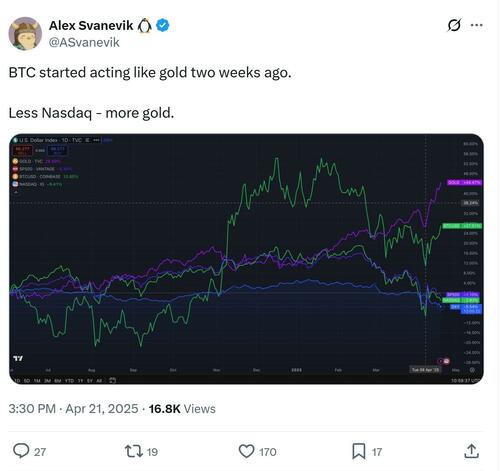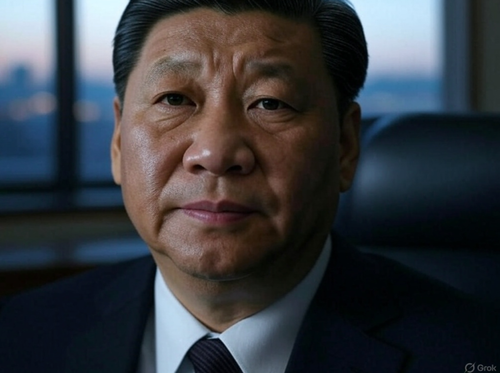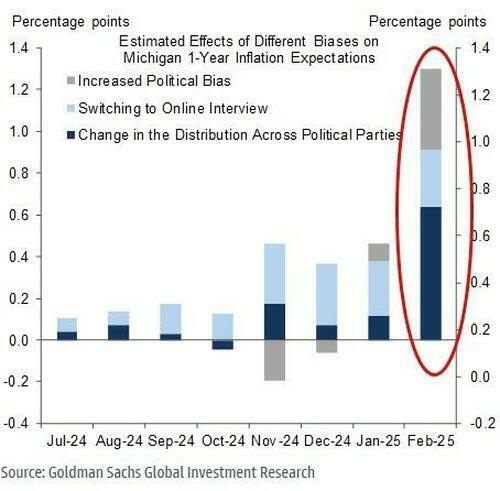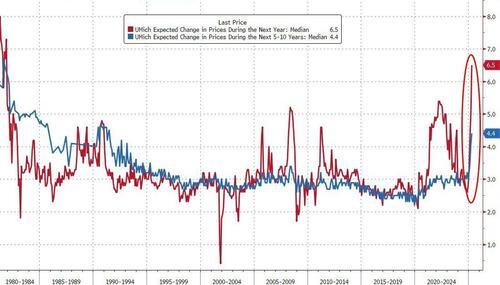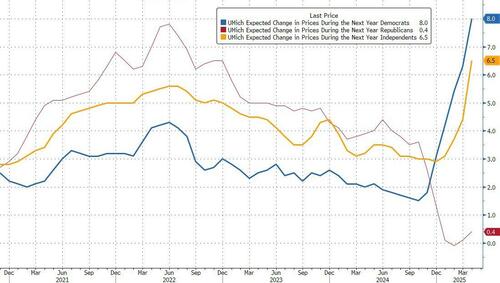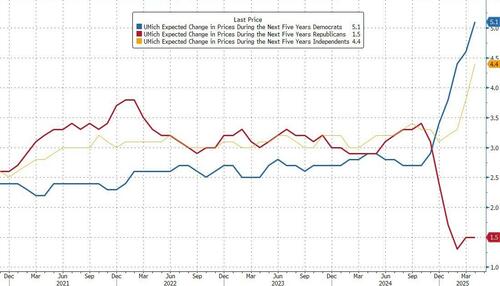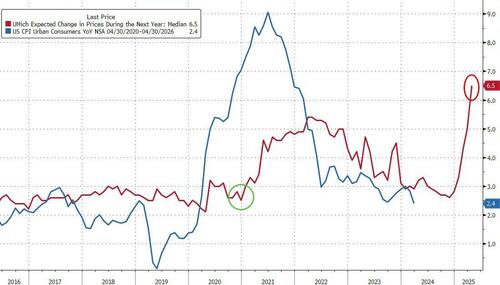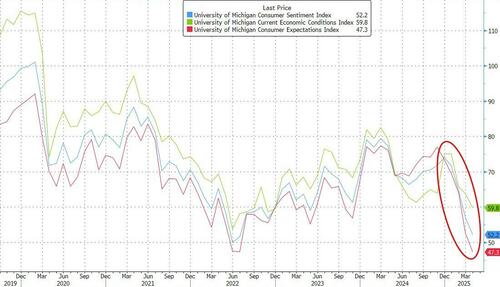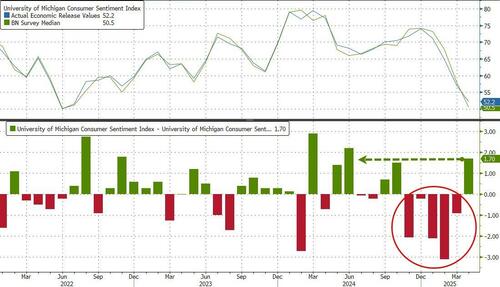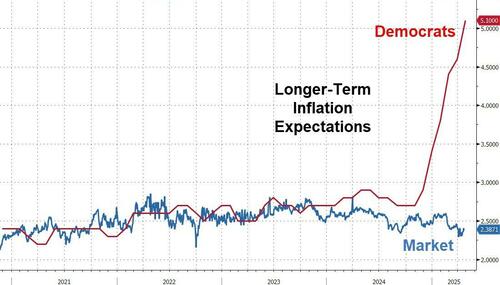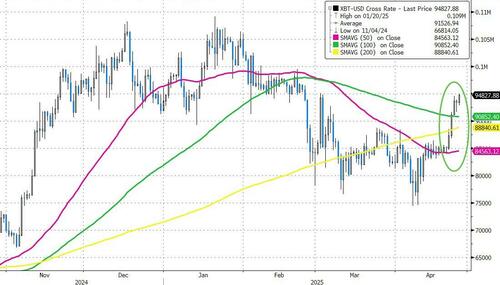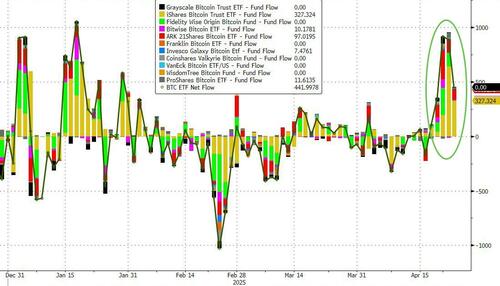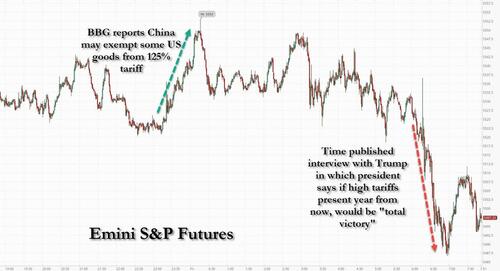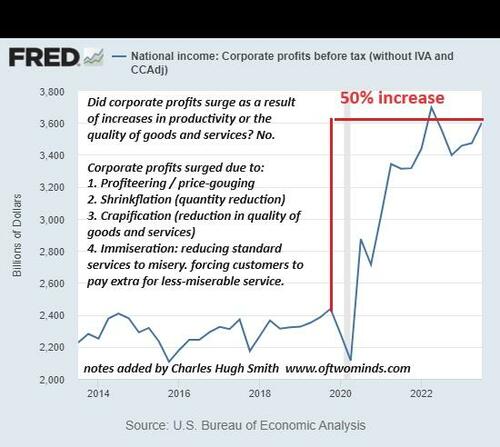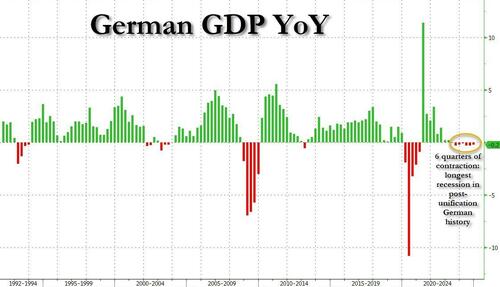In the name of tolerance, tolerance is being abolished; this is a real threat we face.
Distinction Matter - Subscribed Feeds
-
Site: LifeNews
Melinda French Gates said she experienced “almost a crisis of faith” before embracing a pro-contraception stance, citing a “very liberal” priest as a key influence in her decision to diverge from Catholic teaching.
In an April 17 interview on The Jamie Kern Lima Show, the philanthropist and co-founder of the Bill & Melinda Gates Foundation described how her travels to underserved areas exposed her to families living without contraceptives, People reported. Gates recounted hearing from women who experienced pregnancies in rapid succession — some of which led to the loss of a child or even the mother’s death.
“[T]hey would talk about children,” she said, according to People. “And both the men and the women knew that when they could space the births of those children, they were better off.”
Please follow LifeNews.com on Gab for the latest pro-life news and info, free from social media censorship.
Gates said those stories prompted a personal spiritual conflict.
“I started to realize, I believe in life. I believe in these children’s lives. The worthiness of them, the inherent beauty on the day they’re born,” she said. “But because of a man-made rule in the church that I am in — the Catholic church — we’re not allowing women to have access to contraceptives. And so talk about an incongruency, right? And I had to really then reckon with my faith.”
She described her struggle as “almost a crisis of faith” and turned to scholars at Notre Dame to better understand Church teaching.
Her perspective shifted, she said, after reading the writings of Father Richard Rohr — whom she inaccurately described as a Jesuit. Fr. Rohr is a Franciscan friar and author widely known for promoting progressive theology and spirituality, including positions that diverge from the Magisterium.
“I need to actually unlearn some of these things,” Gates said, “because I can’t square the circle.”
Gates said she ultimately concluded that she believes “in the dignity of life” but felt compelled to speak publicly in support of contraception, believing she had a responsibility to use her platform to advocate for what she called “a tool” for women.
LifeNews Note: Rachel Quackenbush writes for CatholicVote, where this column originally appeared.

The post Melinda Gates: A “Very Liberal” Priest Confirmed I Can be Catholic and Pro-Abortion appeared first on LifeNews.com.
-
Site: Catholic Herald
ROME – Tradition holds that during the anti-Christian persecution of Roman Emperor Valerian in 258, St Lawrence, when given three days to round up the church’s riches before being executed, sold the church’s vessels and gave the money to the poor.
When summoned by Valerian to deliver the church’s property, wealth and treasures, Lawrence triumphantly appeared, ushering in the city’s poor, crippled, blind and suffering masses behind him.
As Pope Francis is laid to rest Saturday, in addition to the various heads of state, dignitaries and celebrities scheduled to attend, also present will be those to whom he dedicated the entirety of his priestly, episcopal and Petrine ministry: the poor.
Not only will groups of the poor, homeless, migrants and refugees be present at his funeral Mass in the Vatican, they will also be welcomed to his final burial place, the Basilica of St Mary Major, by a group of poor and needy people.
Having chose the papal name Francis after St Francis of Assisi, often called the “Poor Man of Assisi” due to his embrace of poverty and shunning of material wealth, Pope Francis shortly after his election told journalists that he was inspired to take the name when, immediately after the final vote was counted in the 2013 conclave and he knew he’d been elected, a fellow cardinal sitting next to him said, “don’t forget the poor.”
Pope Francis went to great lengths throughout his pontificate to prioritize the poor and those on life’ margins, making his first trip outside of Rome to the Italian island of Lampedusa, a primary destination point for migrants and refugees arriving to Europe, if they survived the dangerous voyage across the Mediterranean Sea.
He was known for hosting lunches with the homeless and poor for his birthday celebrations, eating lunch with them inside of the Vatican’s Paul VI Hall, and inviting them inside of the Vatican Museums, or sending them on beach holidays with the help of his almoner, Polish Cardinal Konrad Krajewski.
Francis gave Krajewski a red hat in 2018, indicating just how high of a priority charitable outreach to the poor was for him. He also repeatedly sent Krajewski on humanitarian missions to Ukraine after the outbreak of war in 2022, delivering ambulances filled with food and medical supplies.
In 2016, after making a last-minute daytrip to the Greek Island of Lesbos, a trip made solely to visit refugees stuck on the island, he took 12 Muslim refugees back with him, including six children. He visited the island again, and its largest refugee camp, in 2021.
He also consistently advocated for the safe and secure passage of refugees from camps into Italy through humanitarian corridors, ensuring a protected route for those with their paperwork in order and help integrating into their local communities.
The Vatican in an April 24 statement said the poor not only hold a privileged place in the heart of God, but “This is so also in the heart and magisterium of the Holy Father, who chose the name Francis so as never to forget them.”
“For this reason, a group of poor and needy people will be present on the steps that lead to the Basilica of Saint Mary Major to give a final farewell to Pope Francis before the entombment of his coffin,” following his funeral April 26.
Pope Francis’s funeral Mass is scheduled to take place April 26, at 10a.m. local time, and afterwards he will be taken by car to Saint Mary Major, where he will be entombed in the Pauline Chapel, which also houses the famed Marian icon, Maria Salus Populi Romani, or Mary, Health of the Roman People, which was one of his favorite devotions.
Attending his Mass, according to the Community of Sant’Egidio, an ecclesial movement dedicated to social justice that Pope Francis was close to, will be a group of poor, migrants and refugees.
In an April 25 statement, Sant’Egidio said members, including top leadership, would attend the pope’s funeral along with “his people, starting with the poor who knew and loved him during the course of his pontificate.”
These people, they said, include refugees who returned from Lesbos on board the papal plane with him in 2016, as well as refugees from a camp in Cyprus who came to Italy through its humanitarian corridors program in 2021, following his visit to Greece and Cyprus.
Homeless individuals will also attend, including many who found hospitality and welcome at the Palazzo Migliori, which was inaugurated by Pope Francis in 2019 and entrusted to Sant’Egidio.
Sant’Egidio indicated that the group of poor and needy who will welcome Pope Francis’s coffin to Saint Mary Major also belong to their community.
(Pope Francis greets two young refugee girls at the Reception and Identification Centre (RIC) in Mytilene on the island of Lesbos on December 5, 2021. Photo by Louisa GOULIAMAKI / POOL / AFP)

The post ‘Poor’ to honour Francis at papal funeral first appeared on Catholic Herald.
The post ‘Poor’ to honour Francis at papal funeral appeared first on Catholic Herald.
-
Site: Zero HedgeApple Turbocharges Friendshoring: Your Next iPhone Could Be Made In IndiaTyler Durden Fri, 04/25/2025 - 11:20
Apple is turbocharging its "friend-shoring" strategy, thanks in large part to President Trump's ongoing trade war with Beijing, by initiating plans to shift all iPhone production for the U.S. market from China to India starting next year, according to the Financial Times, citing sources. The move marks a significant step toward diversifying Apple's supply chain away from China, in an effort to avoid tariffs.
The sources said the continued diversification of the supply chain into India may suggest that iPhone production could be ramped up to 60 million units by the end of 2026, or the amount required to satisfy the U.S. market.
Apple still relies heavily on Chinese suppliers for components, but final assembly is being relocated to Indian facilities operated by Foxconn and Tata Electronics. Unbeknownst to U.S. consumers, Apple has already ramped up production of Indian-made iPhones to avoid the 145% tariffs Trump imposed on China.
Daniel Newman of the Futurum Group research firm said Tim Cook's friend-shoring of iPhone production out of China to India (for the U.S. market) "is going to be an important move for the company to be able to maintain its growth and momentum," adding, "We are seeing in real time how a company with these resources is moving at relative light speed to address the tariff risk."
In Trump's first term—or around 2017—Apple began manufacturing iPhones in India, starting with the iPhone SE through its manufacturer, Wistron, in Bengaluru. By 2019, Apple had expanded its manufacturing footprint in the country to begin assembling the iPhone XR, and by 2022, it began production of the iPhone 14 in Tamil Nadu.
The latest data from the International Data Corporation showed that U.S. consumers purchased 28% of Apple's 232.1 million global handset shipments in 2024.
Earlier this month, Trump imposed a reciprocal tariff of 26% on India, although it was paused several days later while New Delhi and Washington negotiators discussed a new trade agreement. U.S. Vice President JD Vance is on a trip this week in India, telling reports that US-India trade talks were making "very good progress."
For more color on Apple's trading partners and latest shipments, the supply chain platform Sayari shows Apple India Private Limited's activity, sourcing mostly from China...
It only took Trump's trade war to get CEO Tim Cook very serious about diversifying supply chains out of China into friendlier countries. While friend-shoring is a must, what about re-shoring?
-
Site: Catholic Herald
The death of Pope Francis leaves us with some very different narratives and perspectives of who he was and how we might assess his life and pontificate. We are faced with trying to reconcile some of the many contradictions his pontificate presented to both the Church and the world. One element with a significant degree of confusion is the way the Press understood him.
We are left with the paradoxical impression that he might have been more popular with the secular Press than he was with the Church. He was almost universally celebrated by the media. The response within the Church was a matter of greater complexity.
It was press coverage and the way it chose to celebrate some issues, while closing its eyes to others that appeared inconsistent, that has been critical to the forging of the reputation of Pope Francis when alive and posthumously.
We might well ask why the media, so long suspicious and resentful of Catholicism, has given Pope Francis such a welcome.
The Press depicted Benedict XVI as the hardline “God’s Rottweiler” because his intellectual gifts and personal reserve played poorly with populist sentiment. Had he been judged by some of his work on redistributive economics, the Left might have discovered him as, in terms of social redistribution, one of their own.
It might indicate that the press is driven by feelings and superficial judgements. And as it happened, Pope Francis was masterful in the way that he gave the Press comments that were high octane in the currency of “feeling”, and didn’t trouble them to much over any complexity of content.
It would be too simplistic to assume that it was just that he was making the faith more congenial to their world view by diluting, since looking back, (with the exception of the death penalty) he changed little.
And yet, he did have the capacity for “reading the room” and finding way to touch a populist nerve in a way that gained public confidence and sympathy.
Some of his sound bites were astonishingly effective, even though when they are more closely examined, they don’t stand the weight of scrutiny.
He had in particular, a gift for presenting an image of non-judgemental compassion, with just a hint of a progressive tint that the secular world responded to with an instinctive welcome and crucially without asking too many questions.
His apparent off the cuff remark “who am I to judge?” made during an on-flight informal press conference, might on its own be seen to have come to define his public persona.
Why does secular culture react so powerfully to embrace non-judgementalism when it finds it? In part because its supposed hatred of judgmentalism is a symptom of its rejection of traditional ethics. Ethical restraint interferes with hedonism, and is therefore taboo. And Catholics do restraint.
In the ears of the media, “Who am I to judge” sounds like a signal that Catholic ethics have been abandoned and replaced by the sanction of “all that matters is sincerity”, which along with “intending no harm”, is one of the few ethical standards modernity is willing to tolerate.
In fact, “who am I to judge” was a carefully parsed remark which when read in context carries a very different message from the universal spin placed on it by the media. But the emotional feel of it entirely overwhelmed the contextual limitations and it became a celebratory meme in its own right. It did nothing to change the teaching of the Church, but it gave the impression that the teaching was changed or changing. And the Press delighted in it, ran with it endlessly.
A number of the Pope’s well-tuned remarks became almost catch phrases. In 2013, he movingly declared: “How I would like a Church which is poor and for the poor!” This immediately was seized as an antidote to the public perception that the Church was inexcusably rich and irresponsibly powerful.
Alongside his much-publicised willingness to take public transport as an Argentinian bishop and embrace the marginalised wherever he found them, this was viewed very favourably, and became an indication of his humility and integrity. When he made it known that he would live in Casa Santa Marta instead of the papal apartments, the public celebration of his down to earth values was ecstatic. “People can come only in dribs and drabs (in the official apartments), and I cannot live without people,” he explained. “I need to live my life with others.”
But observers of life in Casa Santa Marta suggested a different narrative was at least partially at work. They pointed out that one of his most prominent personality traits was the need to micromanage. And for this he needed to be kept in touch with people and what people were saying. The scale between gathering information and enjoying gossip is a subtle one, but the need to been informed and remain in control may well have played a significant part, alongside his humility, in his wanting to avoid seclusion and exclusion in the papal apartments.
That humility on closer inspection was a little patchy. But of course, the Press did not offer closer inspection.
There is an unhappy video of a line of well-wishers coming to him to pay their respects and kiss his papal ring. It clearly meant a great deal to those queueing, even if he found it offended his sense of humility. The body language optics were awful. The Pope impatiently was seen whipping his hand away just as each person reached out for it. It looked more like petulance than humility. But then, who are we to judge? Certainly, the Press decided to ignore it.
It is of course true that Pope Francis was assiduous in taking well-judged actions in helping the marginalised when he could. His provision of showers and facilities for the homeless in Rome was once again rightly welcomed, recognised and publicised by the Press. They liked that very much. It accorded with their picture of him. And so, practising a pronounced cognitive dissonance they blanked his remarks on other shibboleths, including and especially abortion. Yet these were as emotionally charged as they were uncompromising and were completely ignored.
Abortion, “It’s like hiring a hitman …”
“… I have had occasion to return to the subject of abortion recently. You know that I am very clear about this: it is a homicide and it is not licit to become an accomplice.”
“… We are victims of the throwaway culture…there is the throwing away of children that we do not want to welcome. Today this has become a normal thing, a habit that is very bad; it is truly murder. In order to truly grasp this, perhaps asking ourselves two questions may help: is it right to eliminate, to end a human life to solve a problem? Is it right to hire a hitman to solve a problem?”
On other controversial issues, he could be and was also crystal clear:
“Gender ideology? It is the greatest danger; it resembles the method with which the Hitler Youth was trained.”
Will there be women priests or deacons? “No.”
Will ecclesiastical celibacy be abolished? “I won’t do it.”
Can gay couples be blessed? “People are blessed, not the union, marriage and family are born from a man and a woman.”
Euthanasia and assisted suicide? “They are practices to be rejected, daughters of the throwaway culture.”
And the rented womb? “It’s modern slavery.”
The many of the obituaries of Pope Francis demonstrate the tension that arose from the mixture of progressive soundbites accompanied by what appeared to a desire to shake the institution while remaining wholly orthodox on certain hot button ethical issues.
There was something to please and infuriate everyone. German progressives were delighted at the ambiguities introduced over gay blessings, and furious that feminist assaults on the diaconate were resisted. Traditionalists were devastated by the unexplained blitzkrieg on the Latin Mass, but reassured by the clarity on abortion. “Who am I to judge” captured the hearts of those who wanted a move towards LGBTQ+ sympathies, but became more problematic when applied to Fr Marko Rupnik’s alleged rape of nuns, and the conniving at the hiding of other clerical sex abusers.
All this too did not fit into the narrative the media built about Francis so it was left largely unreported.
The Press had constructed the public persona of the Pope in their own image, and they were and are reluctant to allow other facts or pieces of information to disturb what they had found so comfortable and comforting. As always, reputation as well as beauty is in the eyes of the beholder.
(Archbishop of Barcelona Cardinal Juan Jose Omella speaks to members of the media at the Barcelona cathedral during an impromptu press conference in Barcelona, on April 21, 2025. Photo by Josep LAGO / AFP)

The post The media’s selective understanding of a complexed pope first appeared on Catholic Herald.
The post The media’s selective understanding of a complexed pope appeared first on Catholic Herald.
-
Site: Ron Paul Institute - Featured Articles
As part of its border strategy, the administration deported Venezuelan migrants to a notorious prison in El Salvador, claiming the deportees were Tren de Aragua gang members. Because of the nature of gang documentation, the claim that they are all violent gang members is dubious. The policy is more than a legal civil liberties nightmare; it is strategically ill-advised. Deporting suspected gang members will not stop gangs. Transnational gangs are a serious problem, but there is a better way to deal with them.
Many have heard of the MS-13 gang because of its penchant for violence. Few, however, know that MS-13 was a small crew for much of its early history before becoming one of the largest criminal enterprises in the world. How did this happen?
Researchers have argued that immigration reforms in the mid-1990s had the unintended consequence of spreading criminal networks. University of California, San Diego, anthropology professor Elana Zilberg made the observation in her book “Space of Detention” that America’s policy of deporting Salvadoran youth contributed to the spread of MS-13. The gang was born in Los Angeles, but it flourished in Central America only after the United States shipped its members back to unstable countries with policies that exacerbated gangs. Rather than eliminating MS-13, the problem was exported, and then it boomeranged back even stronger to the United States.
President Trump is poised to repeat the same mistake. In his first term, Trump “pointed the finger” at President Barack Obama, suggesting that Obama’s “open-door immigration” was responsible for MS-13 prominence. However, the gang’s size and strength were established before Obama, and the argument does not explain MS-13’s success in other countries.
A key flaw in Trump’s approach and America’s handling of gangs is the belief that harsher punishments prevent gang activity. While deterrents are needed, gangs are fundamentally different from typical petty criminals.
In 2019, Erin Yoshino of the University of Southern California studied why harsher penalties for gang members are ineffective, finding that longer sentences do not deter crime and that people join gangs knowing full well that death is a possibility. Instead, incarceration can enhance respect and loyalty among gang members as they maintain control from jail. If threats of mortal danger or prison do not dissuade gang membership, a one-way flight to a Salvadoran prison is unlikely to do better.
People join gangs for various social reasons, such as feelings of belonging or a sense of protection, but they thrive and grow violent as money-making enterprises, primarily through the sale of illicit drugs. Steven Levitt, known for “Freakonomics,” researched how the allure of reaching the top is a strong motivator for drug dealers despite the perils and terrible working conditions. The potential rewards outweigh the risks of imprisonment or death for those who accept the job.
To dismantle transnational gangs, our policies must hit them where it truly stings: their wallets. Researchers know how to do this, but it has not been politically correct to talk about it because it is unpopular to acknowledge defeat, and cognitive bias keeps us from exploring research-backed but counterintuitive policies.
To fight gangs, the strongest weapon is legalizing drugs to undercut their primary source of revenue. The decriminalization of cannabis in the United States has dealt a blow to Mexican cartels, resulting in lower crime rates and gang activity.
Scholars have understood this for decades. Several Nobel laureates have made it a point to publicly express that the war on drugs has failed, all while leading to corruption and violence.
People who advocate for drug prohibition often claim the moral high ground. This is understandable, but they are propping up what they claim to oppose in practice. It is the classic “Baptists and bootleggers” story: the moralists and the criminal profiteers are on the same team as they both want drugs to be illegal. The former claims moral victory, while the latter benefits from governments inadvertently creating lucrative black markets.
Social norms against iniquitous drug use should remain, but it is time to recognize the ineffectiveness of banging our heads against the wall regarding past “get tough” policies toward international drug gangs. The strategy of mass deportations will not stop gang violence. Strip the gangs of their profits. That’s how you defeat them.
Reprinted with permission from Independent Institute.
-
Site: Zero HedgeGold: The Everything HedgeTyler Durden Fri, 04/25/2025 - 11:00
Authored by James Rickards via DailyReckoning.com,
It’s a subject we analyze continually, and we have recommended gold as part of a sound investment portfolio for years. Today the dollar price of gold is hovering near all-time highs over $3,300 per ounce.
Gold has been on a tear lately. It was $1,830 as of October 5, 2023. At today’s prices, that marks a 75% surge in just 18 months. Gold has outperformed stocks by a wide margin this year, but it has also outperformed stocks for the past twenty-five years. Gold was around $250 per ounce in 1999. The gain since then is 1,180% or almost 12 times the starting price.
This is not the first bull market for gold. In the gold bull market of 1971 to 1980, gold rose 2,185%. In the gold bull market of 1999 to 2011, gold rose 670%. There were notable gold bear markets from 1981 to 1999 and again from 2012 to 2015. There were no bull or bear markets before 1971 because the world was on a gold standard and the price was fixed at $35.00 per ounce from 1944 to 1971. Still, the upward trend in gold prices is relentless and undeniable. Taking the entire period from 1971 until today including bull and bear markets gold has risen over 9,000%. Not bad.
Of course, that’s all in the past. What investors want to know is where do we go from here? The short answer is up significantly.
Here’s Why
The most fundamental reason for the rise in gold prices is simple supply and demand. Central banks predominantly from developing markets moved from being net sellers to net buyers of gold in 2010. Total gold reserves of central banks have risen significantly since then from just over 30,000 metric tonnes (mt) to over 35,000mt today.
The top buyers were the central banks of Russia, China, Turkey, Poland and India. Russia increased its reserves by 1,684mt to a total of 2,333mt. China increased its reserves by 1,181mt to a total of 2,235mt. Iran is also a major buyer of gold, but it is non-transparent, and its purchases and reserves are not publicly known.
At the same time gold demand has been growing, gold output is flat. Global mining output of gold was about 130 million ounces in 2018 and was about 120 million ounces in 2024. Output declined slowly from 2018 to 2022 and then recovered slowly over the course of 2023 and 2024 but the change in both directions was slight.
Gold production is projected to grow slightly from today until 2030 but is still not projected to exceed the 2018 high. In short, gold production by miners is flat. This does not mean that we are at “peak gold” or that new discoveries are not being made. They are. What it means is that gold is becoming harder to find and costs of production (especially water and energy) are going up, so the total output trend is flat.
Continually increasing demand with flat output is a recipe for higher gold prices.
The second driver of higher prices is the role of BRICS+. From an original membership of Brazil, Russia, India and China in 2009 (South Africa joined in 2010), the group has expanded to include Egypt, Ethiopia, Indonesia, Iran and the UAE. It’s waiting list of additional members who will be added in the years ahead includes Malaysia, Nigeria, Turkey and Vietnam among others.
There was much discussion in 2023 and 2024 about a new BRICS currency that would displace the U.S. dollar in trade among members and might ultimately prove to be an acceptable reserve currency to rival the dollar. In fact, no such alternative currency is in the works. It might happen in the future but it would take ten years or longer properly to design and implement.
Instead, the BRICS are building a new payments system using proprietary cables, secure servers and highly encrypted message traffic protocols along with a blockchain-type ledger. Payments are in local currencies in the new payment channels that cannot be disrupted by western powers.
This begs the question of how trade imbalances accumulating in local currencies can be settled and converted into more liquid assets. The traditional answer was dollars. In short, the BRICS+ already have a new global currency, which is actually quite old – it’s gold. This is one reason why BRICS+ members are among the largest buyers of gold bullion.
The Everything Hedge
Importantly, gold is not just an inflation hedge, in fact it is an imperfect inflation hedge in terms of strict correlation. Gold prices have skyrocketed in recent years even as inflation has remained relatively tame (despite an inflation surge in 2022). A better model is to think of gold as the “everything hedge.”
The vectors of uncertainty are everywhere. These include tariffs, tax policy, the Department of Government Efficiency (DOGE), the War in Ukraine, the rise of China, a likely recession, left-wing violence, and even the status of Greenland and the Panama Canal among others.
It’s difficult to forecast how any one of these situations will turn out, let alone all of them and their complex interactions. Stocks and bonds can be volatile as a result. Gold is the one safe haven asset that powers through them all and offers investors some peace of mind. It is truly the everything hedge.
These drivers are sending gold prices higher and putting a floor under current price levels so that investors can enjoy potential upside with reduced concern about the downside. That’s what we call an asymmetric trade, which greatly favors investors.
Finally, there’s a simple bit of math combined with behavioral psychology that could propel gold prices to the $10,000 per ounce level in far less time than most analysts believe.
Investors naturally focus on dollar gains in the price of gold. When gold goes from $1,000 per ounce to $2,000 per ounce, investors cheer on the $1,000 gain. The same is true when gold goes from $2,000 per ounce to $3,000 per ounce. Again, investors pat themselves on the back for another $1,000 per ounce gain.
What investors don’t realize at least initially is that each $1,000 per ounce gain is easier than the one before. This phenomena involves the interaction of simple math and more complicated behavioral psychology.
The psychology is a matter of what’s called anchoring. The investor anchors on the number of $1,000 as a fixed gain and treats each such gain as the same. In pure dollars, they are the same. You make $1,000 per ounce as each benchmark is passed.
But here’s the conversion of those dollar benchmarks with each gain translated from dollars per ounce to percentages of the prior baseline:
Because each $1,000 per ounce gain begins from a higher level, the percentage gain associated with each dollar gain is less. The increase from $1,000 to $2,000 per ounce is a heavy lift. The increase from $9,000 to $10,000 per ounce is not much more than a good month. (Gold has been going up 1% to 2% daily with recent volatility).
This math is what gives rise to a gold buying frenzy. We’re not there yet. Gold buying has been limited mostly to central banks and large institutions such as sovereign wealth funds (SWFs). Retail interest in the U.S. has been slight although retail buyers have been more active in India and China. Once the frenzy kicks in those $1,000 benchmarks will be passed quickly. That’s why it’s not too late to become a gold investor. Don’t kick yourself about the gains you’ve missed. Instead, look forward to the gains that are coming.
How To Invest
The two main ways to invest in gold are what I call paper gold and physical gold bullion. Paper gold refers to securities and futures linked to the price of gold such as exchange-traded funds (GLD is the most liquid ticker), COMEX gold futures or unallocated gold purchase agreements available from large banks. Paper gold will give you price exposure and the potential for gains, but you do not own gold bullion. Many things can go wrong with a paper gold strategy including early termination of contracts, closure of futures exchanges or the failure of a dealer bank. You may find that you’re out of the gold market just when you most want to be in it.
Physical bullion is my preferred way to invest in gold. American Gold Eagle coins from the U.S. Mint in one-ounce or one-quarter ounce denominations are practical. For larger amounts you can look at 1-kilo gold bars from a reputable refiner. Do not buy “rare” or “pre-1933” gold coins unless you are a collector or numismatic expert. The premium for such coins is high and they are not worth the extra expense. Gold is gold.
Do not store your bullion in a safe deposit box. Banks are the first place the government will lock down in a crisis. Your gold could be seized. Use a private storage company like Brinks or install a home safe. If you’re using a home safe there are several techniques you can use to protect it. The best protection is not to tell anyone you have gold. That way no one will come looking.
-
Site: Ron Paul Institute - Featured Articles
Is Trump’s plan to end the Ukraine conflict a dead letter on arrival? A ceasefire is not peace. Freezing the conflict does not address security issues. Washington provoked this conflict. This is why Trump’s attempt to mediate is doomed to fail.
CrossTalking with Daniel McAdams, Hall Gardner, and Alexandre Guerreiro.
!function(r,u,m,b,l,e){r._Rumble=b,r[b]||(r[b]=function(){(r[b]._=r[b]._||[]).push(arguments);if(r[b]._.length==1){l=u.createElement(m),e=u.getElementsByTagName(m)[0],l.async=1,l.src="https://rumble.com/embedJS/ujcwo5"+(arguments[1].video?'.'+arguments[1].video:'')+"/?url="+encodeURIComponent(location.href)+"&args="+encodeURIComponent(JSON.stringify([].slice.apply(arguments))),e.parentNode.insertBefore(l,e)}})}(window, document, "script", "Rumble"); Rumble("play", {"video":"v6qcyz5","div":"rumble_v6qcyz5"}); -
Site: Ron Paul Institute - Featured Articles
Supporters of liberty had much reason for hope due to Robert F. Kennedy, Jr. becoming secretary of the Department of Health and Human Services (HHS). This man’s tenacity and eloquence in challenging the coronavirus crackdowns suggested great potential accomplishments for both liberty and health at HHS with him in the lead.
Indeed, there are early signs that HHS under Kennedy’s oversight is seeking to roll back the dangerous to health and liberty extreme vaccine pushing mission the department has pursued in recent decades. But, there is also reason to worry — including news earlier this month of the HHS fast-tracking an experimental bird flu shot — that this roll back will turn out to be quite limited.
One thing surprising people is that Kennedy’s HHS is acting like a police baton to whack American institutions and individuals into submission to the demand that they show allegiance to the Israel government. First, HHS became one of three parts of the US government leading an effort to punish colleges if they fail to stomp out “antisemitism” — defined bizarrely to include criticism of the Israel government — communicated by leadership, employees, or students. Kennedy, in the announcement of this endeavor, even made the extraordinary claim that such targeted free speech, press, and assembly is a manifestation of illness. This is the same sort of “medicalization” of ideas and communication that the Soviet Union employed to suppress dissent.
Then, this week, came news that HHS subsidiary the National Institutes of Health (NIH) has, effective immediately, barred any entity that boycotts Israel from continuing to spend, or receiving any new, NIH grants. Given the importance of NIH grants in medical research, this new demand threatens to shut down much research and upend the lives of many people employed in research projects. All this is done based on a criterion that has nothing to do with the task-relevant qualifications of the grant seekers or the quality of their work. Out with merit. In with kissing up. That does not seem conducive to achieving Kennedy’s often repeated goal to Make America Healthy Again. It also seems a big divergence from the protecting liberty objective many Kennedy supporters hoped he would pursue.
These actions from HHS are in a way not a surprise because Kennedy made clear in his 2024 presidential run that he was a major booster for the Israel government, praising it without caveat. He even went so far as to make the following declaration in a Twitter post: “As President, my support of Israel will be unconditional.” But, at the same time, it seemed reasonable to think that, given HHS’s focus on health matters in America, Kennedy’s Israel views would be irrelevant in his new job. Well, surprise, surprise: In the Donald Trump administration it turns out that, with Kennedy at the helm, even HHS can put Israel First.
During the coronavirus crackdowns, Kennedy stood up for people who opposed taking experimental shots, wearing masks, or going along with other government admonitions and dictates. But, now his HHS, reminiscent of the “Soup Nazi” in the Seinfeld episode, is saying “no funding for you” if you don’t stand with Israel. What a letdown.
The HHS thought police are on the march. Fail to fall in line in support of the Israel government and you will be punished. HHS and its fellow US government departments have not reached the level of domination used to ensure love for Big Brother in George Orwell’s 1984. But, hey, the Trump administration is just three months into its Israel boosting operation. These things take time.
-
Site: Zero HedgeFBI Arrests Wisconsin Judge Accused Of Helping Illegal Immigrant Hide From ICE: PatelTyler Durden Fri, 04/25/2025 - 10:40
FBI Director Kash Patel announced Friday that the bureau has arrested Judge Hannah Dugan out of Milwaukee, Wisconsin on charges of obstruction, accusing the Dugan of obstructing an arrest of illegal immigrants last week.
“We believe Judge Dugan intentionally misdirected federal agents away from the subject to be arrested in her courthouse, Eduardo Flores Ruiz, allowing the subject — an illegal alien — to evade arrest,” Patel said in a brief statement shared on X - which was subsequently deleted and re-posted. “Thankfully our agents chased down the perp on foot and he’s been in custody since, but the Judge’s obstruction created increased danger to the public.”
No word on why Patel's post was removed.
The bombshell arrest comes after radio host Dan O’Donnell reported that a federal investigation had been launched Dugan, who was said to have assisted an illegal alien evading FBI and ICE agents attempting an arrest at the courthouse. The alleged incident occurred after a clerk was notified of federal agents’ arrival to apprehend the illegal alien.
WSAU reports:
She then allegedly allowed the illegal migrant to hide in her jury room, which traditionally is not open for defendant use.
Chief Judge Carl Ashley allowed the agents to enter Dugan’s courtroom after he was presented with a warrant to enter the building and arrest the suspect, which led them to learning of Judge Dugan’s alleged obstruction.
The sources told O’Donnell that Chief Ashley sent an email to his fellow judges explaining the incident and said, “All of the agents’ actions were consistent with our draft policies, but we’re still in the process of conferring on the draft,” to which Judge Dugan responded by claiming that a warrant wasn’t “presented in the hallway of the 6th floor,” where her courtroom is located.
New video from our crews: Milwaukee County Judge Hannah Dugan and her attorney leaving the federal courthouse in Milwaukee and not commenting. The FBI arrested her at the MKE Co Courthouse this morning. She's charged with 2 felonies for obstructing an ICE arrest last week pic.twitter.com/3YtgsNHTJl
— Matt Smith (@mattsmith_news) April 25, 2025Obstructing federal officers or providing false information in an investigation carries serious penalties. Under 18 USC § 1001, such actions are felonies, punishable by up to five years in prison, or eight if terrorism is involved, WSAU reports.
This incident follows a memo from Gov. Tony Evers’s Department of Administration, advising state employees they can avoid cooperating with federal agents by declining to answer questions or provide access to files or systems without legal counsel, even when presented with a warrant, according to the local news outlet.
Dugan's arrest follows the arrest of a former New Mexico judge, who is accused of having an alleged Tren de Aragua gang member as a tenant.
Former Doña Ana County Magistrate Joel Cano and his wife, Nancy Cano, were arrested this week at their North Reymond Street home.
The arrests stem from the couple’s ties to Cristhian Ortega-Lopez, an alleged member of the notorious Tren de Aragua gang. As reported by NewsNation affiliate KTSM, Cano rented out a casita on his property to Ortega-Lopez at his wife’s urging last year after she hired the suspect for household chores, the criminal complaint reads.
Two judges down in the past 24 hours.
— Benny Johnson (@bennyjohnson) April 25, 2025
Keep it coming.
This is what I voted for. pic.twitter.com/59EO2LYG8V* * *
Psst! - click here for a sneak peek at new offerings at ZeroHedge Store...
-
Site: LifeNews
Tennessee Gov. Bill Lee has signed a pro-life bill protecting the conscience rights of medical professionals like doctors and nurse who don’t want to be forced to participate in abortions.
The bill creates conscience protections for doctors who are morally opposed to certain medical practices, including abortion.
While Tennessee is one of a couple dozen states with abortion bans that protect the lives of unborn children, abortions can still be done in very limited situations. Also, if the law is ever overturned, pro-life doctors and nurses want to be sure their conscience rights are protected to excuse themselves from abortions that will kill unborn babies.
Follow LifeNews on the MeWe social media network for the latest pro-life news free from Facebook’s censorship!
The bill also applies to other medical situations where pro-life medical workers could be required to participate in something like IVF, surrogacy, assisted suicide or euthanasia or other procedures that violate their pro-life consciences.
Alliance Defending Freedom Senior Counsel Greg Chafuen hailed the governor’s signature on the Medical Ethics Defense Act, SB 955.
“Patients are best served by health care professionals who are free to act consistent with their oath to ‘do no harm.’ Unfortunately, doctors and nurses have been targeted for caring for their patients by refraining from harmful and dangerous procedures,” he told LifeNews. “This ends up discouraging countless young professionals from entering the health care field because of fear that they will be forced to violate their conscience.”
He continued: “Tennessee’s MED Act ensures that health care professionals are not forced to participate in procedures that violate their ethical, moral, or religious beliefs. ADF commends Sen. Pro Tempore Ferrell Haile, Rep. Bryan Terry, and the Tennessee Legislature for their fortitude, and we thank Gov. Lee for standing with health care professionals and the patients they serve by enacting the MED Act. We also thank Tennessee Right to Life for its monumental work on this effort. Now, Tennessee health care heroes are free to care for all patients in a compassionate, ethical manner.”

The post Tennessee Gov. Bill Lee Signs Bill Protecting Doctors From Being Forced to Do Abortions appeared first on LifeNews.com.
-
Site: Zero HedgeChina May Shift From US Treasuries Toward Crypto, Gold; BlackRock ExecTyler Durden Fri, 04/25/2025 - 10:25
Authored by Amin Haqshanas via CoinTelegraph.com,
Central banks, particularly China, may start to shift away from US Treasurys, exploring alternatives such as gold and Bitcoin, according to Jay Jacobs, BlackRock’s head of thematics and active ETFs.
In a recent interview with CNBC, Jacobs said that geopolitical tensions and rising global uncertainty are accelerating diversification strategies among central banks.
He pointed to a long-term trend where countries have been reducing their reliance on dollar-based reserves in favor of assets like gold and, increasingly, Bitcoin.
“This whole diversification away from traditional assets and into things like gold and also crypto [...] probably began three, four years ago,” Jacobs explained.
He said that recent geopolitical fragmentation has intensified the push toward alternative stores of value.
Jacobs referenced growing concerns about the freezing of $300 billion in Russian central bank assets following its invasion of Ukraine, suggesting that such events have prompted countries like China to rethink their reserve strategies.
BlackRock executive Jay Jacobs on CNBC. Source: YouTube
Geopolitical fragmentation to shape global markets
During the interview, Jacobs said BlackRock, the world’s largest asset manager, has identified geopolitical fragmentation as a defining force for global markets over the coming decades:
“We really identified geopolitical fragmentation as a mega force that is driving the world forward over the next several decades.”He noted that this environment is fueling demand for uncorrelated assets, with Bitcoin increasingly viewed alongside gold as a safe-haven asset.
“We’ve seen significant inflows into gold ETFs. We’ve seen significant inflows into Bitcoin. And this is all because people are looking for those assets that will behave differently,” Jacobs said.
Investors highlight Bitcoin decoupling
Notably, Jacobs is not alone in stressing Bitcoin’s declining correlation with US equities. Several analysts have also observed that Bitcoin is beginning to decouple from the US stock market.
On April 22, Alex Svanevik, co-founder and CEO of the Nansen crypto intelligence platform, said Bitcoin’s price is showcasing its growing maturity as a global asset, becoming “less Nasdaq — more gold.”
He added that Bitcoin was “surprisingly resilient” amid the trade war compared to altcoins and indexes like the S&P 500, but remains vulnerable to economic recession concerns.
Source: Alex Svanevik
Echoing this sentiment, QCP Capital said in an April 21 Telegram note that Bitcoin seemed to be sharing some of gold’s limelight as a hedge against macroeconomic uncertainty.
“With equities finishing last week in the red and extending an April drawdown, the narrative of BTC as a safe haven or inflation hedge is once again gaining traction. Should this dynamic hold, it could provide a fresh tailwind for institutional BTC allocation,” it wrote.
-
Site: Zero HedgeWho Blinks First? China May Exempt Tariffs On US Ethane & Other GoodsTyler Durden Fri, 04/25/2025 - 10:20
By now it's become increasingly clear that both the U.S. and China are eager to de-escalate the trade war, yet neither is willing to make the first move. In China, export orders are drying up, and factories are shutting down. Meanwhile, across the Pacific Ocean in the U.S., containerized cargo volumes through the Port of Los Angeles are teetering on the edge of a very sharp decline, threatening to send shockwaves through Southern California's economy and beyond.
Early Friday, several media outlets reported that China's government has either considered or exempted some U.S. imports from a 125% tariff rate.
Let's begin with Bloomberg, which cited people familiar with the matter who said Beijing is considering removing tariffs on medical equipment and certain industrial chemicals, including ethane.
As we noted earlier this week, the U.S. is a major supplier of ethane—a petrochemical feedstock and component of natural gas. Ethane is a critical input for China's plastics industry, with few alternative suppliers outside the U.S. Needless to say, any disruption to ethane shipments would severely impact China's plastics sector.
Those sources continued down Beijing's laundry list of potential tariffs to be removed, including waiving the tariff for plane leases... Boeing has caught a sigh of relief.
"It's another step toward a de-escalation of the trade war," said Kok Hoong Wong of Maybank Securities, adding that a trade deal might not be imminent, but certainly, "it would appear the worst may truly be over."
Bloomberg Economics analysts Chang Shu and Eric Zhu commented on the BBG headline:
"Exempting critical, hard-to-replace U.S. products from tariffs would be a pragmatic approach that could ease tensions with the U.S. and serve the interests of Chinese industry. Anything that helps lower the temperature in the trade war is also beneficial from the perspective of avoiding broader clashes with the U.S."
In a separate report, Reuters stated that instead of merely considering exemptions, Beijing has already "exempted" certain U.S. imports from the 125% tariff, citing businesses that were notified by authorities about the change.
"As a quid-pro-quo move, it could provide a potential way to de-escalate tensions," said Alfredo Montufar-Helu, a senior adviser to the Conference Board's China Center.
Montufar-Helu warned: "It's clear that neither the U.S. nor China want to be the first in reaching out for a deal."
Earlier in the week, U.S. Treasury Secretary Scott Bessent warned a US-China trade deal could take 2 to 3 years to finalize.
Bessent emphasized at a closed-door investor meeting on Tuesday: "No one thinks the current status quo is sustainable, at 145% and 125%, so I would posit that over the very near future, there will be a de-escalation. We have an embargo now on both sides."
Both sides may want a deal to avoid further tariff fallout in their respective economies, but neither wants to appear desperate on the global stage. China is grappling with shuttered factories and possible ethane supply woes that threaten to roil its core manufacturing economy, while in the U.S., containerized volumes through the Port of Los Angeles are poised for a steep decline in the coming week
-
Site: Zero HedgeBrainwashed Democrats Continue To See Imminent Inflation-pocalypse; But UMich Sentiment Improved Intra-MonthTyler Durden Fri, 04/25/2025 - 10:17
Having been widely mocked - and quantitatvely denigrated by Goldman Sachs - this morning's final print for UMich consumer sentiment for April is now a must watch.
As a reminder, Goldman explained that the Michigan measure has been especially susceptible to the tariff news recently for three reasons.
First, inflation expectations in the survey have become extremely partisan.
Second, the share of respondents in the Michigan survey who are Democrats has always been consistently higher than the share of respondents who are Republicans
Third, switching from a phone-based to an online-based data collection process has led to more extreme answers on inflation expectations.
These three issues together have boosted short-term inflation expectations in the Michigan survey by about 1.3pp and long-term inflation expectations by 0.5pp since 2024Q4. In particular, the change in distribution across political parties and increased partisanship together generated an outsized 1.0pp boost to the 1-year inflation expectation in February.
So, with all that in mind, let's see what the final data looks like - did it get even crazier?
The short answer is - YES!
UMich 1Yr inflation expectations rose to 6.5% (slightly lower than the 6.8% expected but still the highest since Nov 1981) while the 5-10Y expectations jumped to 4.4% - the highest since June 1991...
Source: Bloomberg
The gaping chasm of propaganda-driven fear is evident below the surface with Republicans expected 0.4% inflation while Democrats expect - wait for it - 8.0% price rises in the next year (Independents also saw inflation expectations rising)...
Source: Bloomberg
Source: Bloomberg
Bear in mind that Democrat's 1Yr inflation expectations are now more than 2 times higher than they were in June 2021 when inflation would actually rise to 9%. Back then the Democrats were only off by a factor of 3x.
The final April sentiment index declined to 52.2 from 57 a month earlier, but this was considerably better than the 50.8 preliminary number and the median estimate of 50.5 in a Bloomberg survey of economists.
"While this month’s deterioration was particularly strong for middle-income families, expectations worsened for vast swaths of the population across age, education, income, and political affiliation," Joanne Hsu, director of the survey, said in a statement.
“ Consumers perceived risks to multiple aspects of the economy, in large part due to ongoing uncertainty around trade policy and the potential for a resurgence of inflation looming ahead."
The survey showed the expectations index plunged 11.4 points, the sharpest drop since 2021, to 52.6 this month. The current conditions gauge decreased to a six-month low of 63.8.
Source: Bloomberg
After five straight months of disappointments, April saw the biggest beat for headline UMich sentiment since June 2024...
Source: Bloomberg
“ Labor market expectations remained bleak,’’ Joanne Hsu, director of the survey, said in a statement.
“ Even more concerning for the path of the economy, consumers anticipated weaker income growth for themselves in the year ahead. Without reliably strong incomes, spending is unlikely to remain strong amid the numerous warnings signs perceived by consumers.”
Compare UMich's survey for the longer-term inflation expectations, according to Democrats, to what the market is pricing in...
Source: Bloomberg
Is it really any surprise that even Fed Chair Jay Powell dismisses this survey's farcical numbers as a partisan outlier.
-
Site: Mises InstituteWhile focusing on the Holocaust, people often forget the economic fallacies of the Third Reich. Hitler‘s policies were based upon socialism and state control, a no regime can prosper under those condition.
-
Site: OnePeterFive

De mortuis nil nisi bonum dicendum est. This Latin phrase means “Of the dead nothing but good should be said.” Its origins, however, are not Latin, but Greek. It is attributed to Chilon of Sparta, whose Greek original is τὸν τεθνηκóτα μὴ κακολογεῖν. This is slightly different than the Latin translation, as the Greek says “let evil words not be spoken against the dead man.” The verb here is…
-
Site: Steyn OnlineProgramming note: Join me tonight for a rather different installment of Tales for Our Time, and then tomorrow, Saturday, for the latest episode of our Serenade Radio weekend music show, On the Town. The latter starts at 5pm British Summer Time - which
-
Site: Steyn OnlineEver since we launched Tales for Our Time almost eight years ago, I have had a persistent ripple of emails from listeners demanding that I set aside our audio fiction and do more audio non-fiction. Except for a few highly specific works, I can't say it
-
Site: Mises InstituteTrump has tried to claim that he favors "Main Street over Wall Street." Unfortunately, by pushing aggressive low-interest-rate monetary policy, Trump has put himself squarely in the camp of “Wall Street over Main Street.”
-
Site: LifeNews
Colorado Governor Jared Polis has signed a bill forcing Colorado taxpayers to fund abortions.
Polis signed SB25-183, a recently approved state measure that would allocate a minimum of $1.5 million per year of taxpayer funds to cover elective abortions. With Colorado having abortions up to birth, that means taxpayers will be on the hook for paying for killing viable babies who could easily live outside the womb.
And with the $1.5 million figure a minimum, Colorado residents may be forced to pay even more to kill thousands of babies.
“One thing pro-life and pro-choice people agree on nationwide is that they don’t want to pay for other people’s abortions, and yet Colorado is asking its citizens to do just that,” said Priests for Life National Director Frank Pavone to LifeNews this morning condemning Polis’ signature.
Please follow LifeNews on Rumble for the latest pro-life videos.
Pavone noted, as have other pro-life advocates, that the amendment Colorado voters passed to make killing babies in abortions a state constitutional right made it clear that state residents would not have to fund abortions.
While 62 percent of Coloradans voted for Amendment 79 in November, removing the prohibition on public funding for abortion, the electorate was informed by the legislative blue book and media that Amendment 79 would not cost the state money. Four months later, the state legislature introduced SB 183 with a 1.5-million-dollar fiscal note in a year when Colorado is in a 1-billion-dollar deficit.
“This is part two of last November’s vote on Amendment 79,” Pavone said. “That misguided and destructive measure creates the fiction that somehow there is virtue enforcing people to pay for child-killing.”
“A Colorado lawmaker recently touted the cost-saving benefits in ‘averted births,’ but abortion averts birth by killing children. These advocates might want to point that out. Polis has just signed a death warrant for his own constituents,” he added.
As the Catholic bishops of Colorado noted:
Recent data show a conservative cost estimate of state-funded abortion is actually more than $2 million per year. In an abhorrent effort to offset the costs, the legislative fiscal note stated that the state will save money because more babies will be aborted, and the cost of abortion is cheaper than the cost of labor and delivery. Such a statement is an egregious reflection of the inhumane mentality behind the bill.
Furthermore, the fiscal note drastically underestimates the cost of abortion, calculating the average abortion at $1,300, which is the average cost of first-trimester abortions only.[2] According to the Colorado Department of Health, abortions after 21 weeks’ gestation make up 3.4% of all abortions in Colorado (the national average is 1 percent). In 2024, 1.1% of Colorado abortions were in the third trimester. Second and third-trimester abortions can cost between $3,000 – $30,000. The fiscal note also does not consider the cost of abortion travel of women outside of Colorado for abortion, which has gone up substantially in the last three years.
This legislation was introduced weeks after several botched abortions by unregulated abortion clinics were reported in Colorado — one of which resulted in the loss of life of an 18-year-old Fort Collins young woman. The value of the lives of preborn babies and their mothers is incalculable, and the impact on our state will be catastrophic.
Every human life, from conception to natural death, is a sacred gift from God. No act of law can change this truth, nor can it erase our moral obligation to defend the most vulnerable among us.
The allocation of millions of dollars in taxpayer funds to subsidize the deliberate ending of innocent life is a tragedy for Colorado. Rather than using state resources to support life-affirming alternatives — such as comprehensive prenatal care, adoption services and resources for women facing unexpected pregnancies — this bill instead prioritizes public funding of abortion at the expense of the lives of preborn children, the health of their mothers and the conscience rights of millions of Colorado taxpayers who morally object to abortion.
Despite the current law in Colorado, the Catholic bishops of Colorado and the three dioceses are committed to doing our part to help pregnant mothers who are considering abortion through the ongoing expansion of medical services, housing, counseling and resources, both during their pregnancy and after.

The post Colorado Governor Jared Polis Signs Bill Forcing Taxpayers to Fund Abortions appeared first on LifeNews.com.
-
Site: Zero HedgeBitcoin Extends Gains As Fed Pulls Biden-Era Guidance On Bank's Crypto DealingsTyler Durden Fri, 04/25/2025 - 09:25
The Federal Reserve Board on Thursday announced the withdrawal of guidance for banks related to their crypto-asset and dollar token activities and related changes to its expectations for these activities.
These actions ensure the Board's expectations remain aligned with evolving risks and further support innovation in the banking system.
Bitcoin prices extended gains above $95,000...
Amid a sudden resurgence in net inflows into BTC ETFs...
The Board is rescinding its 2022 supervisory letter establishing an expectation that state member banks provide advance notification of planned or current crypto-asset activities.
As a result, the Board will no longer expect banks to provide notification and will instead monitor banks' crypto-asset activities through the normal supervisory process.
The Board is also rescinding its 2023 supervisory letter regarding the supervisory nonobjection process for state member bank engagement in dollar token activities.
Finally, the Board, together with the Federal Deposit Insurance Corporation is joining the Office of the Comptroller of the Currency in withdrawing from two 2023 statements jointly issued by the federal bank regulatory agencies regarding banks' crypto-asset activities and exposures.
The Board will work with the agencies to consider whether additional guidance to support innovation, including crypto-asset activities, is appropriate.
Additionally, CoinTelegraph reports that Bitcoin is flashing multiple technical and onchain signals suggesting that a rally to $100,000 is possible by May.
And as we have noted recently, bitcoin continues to track lagged global liquidity almost perfectly...
Combined with bullish chart structures and concentrated short liquidity overhead, BTC remains positioned for a potential move toward $100,000 by May.
-
Site: The Orthosphere
“We may be in the universe as dogs and cats are in our libraries, seeing the books and hearing the conversation, but having no inkling that there is any meaning in it all.”
William James, “Pluralism and Religion,” The Hibbert Journal (1908)*
Speaking as one dog to another, I am inclined to believe that James’ supposition is correct. I would only add that the library is well supplied with superior dogs (and cats) who say they have read the books and understood the conversations, and that only very stupid (or wicked) dogs (and cats) find it hard to believe them.
*) William James, “Pluralism and Religion,” The Hibbert Journal, 6.4 (July 1908), pp. 721-728 , quote p. 724. This was later published in The Pluralistic Universe (London: Longmans, Greens, and Co., 1909), p. 309.
-
Site: LES FEMMES - THE TRUTH
-
Site: LifeNews
On Monday Governor Sanders signed a good law to help teach public school students about unborn children.
S.B. 450 by Sen. Breanne Davis (R — Russellville) and Rep. Kendra Moore (R — Lincoln) lets public school students see a recording of a high-definition ultrasound video as part of human fetal growth and development education courses.
The law also makes it possible for students to learn important facts about how unborn children develop in the womb.
LifeNews is on TruthSocial. Please follow us here.
Similar legislation has passed in North Dakota, Tennessee, Idaho, and Kansas.
With the governor’s signature, S.B. 450 is now Act 915 of 2025. Act 915 received overwhelming support in the Arkansas Senate and House of Representatives, and we want to recognize the legislature for supporting this good law and Governor Sanders for signing it on Monday.
Very few medical advancements have done more to change hearts and minds on abortion than ultrasound technology. In fact, research has shown that some women are less likely to have an abortion if they see an ultrasound image of their unborn child. Act 915 will help students understand that unborn children are human beings.
LifeNews Note: Jerry Cox is the president of the Arkansas Family Council.

The post Arkansas Governor Sarah Huckabee Sanders Signs Law to Teach Kids Fetal Development appeared first on LifeNews.com.
-
Site: Mises InstituteAs Trump challenges Powell and the Fed’s authority, Dr. Joe Salerno joins Bob to dive into whether "central bank independence" really protects the economy—or just shields elite power.
-
Site: Rorate CaeliCardinal Müller granted the following interview to Iacopo Scaramuzzi, for Italian daily Repubblica, and published yesterday:Iacopo ScaramuzziRepubblicaRome, April 24, 2025“The future pope is not a successor of his predecessor but a successor of Peter": thus German Cardinal Gerhard Ludwig Müller, a member of the conservative wing of the College of Cardinals.Your Eminence what are your New Catholichttp://www.blogger.com/profile/04118576661605931910noreply@blogger.com
-
Site: AsiaNews.itTension remains high between Delhi and Islamabad after the attack in Kashmir that left 26 dead. Airspace closed, agreement on rivers revoked, Hindu nationalists press for armed retaliation. The vice-president of the Bishops' Conference: 'May our efforts for peace continue.'
-
Site: Zero HedgeFutures Slide After Trump Interview Reverses Boost From China Tariff Cut ReportsTyler Durden Fri, 04/25/2025 - 08:29
US equity futures are mixed after three days of gain, with tech leading, highlighted by GOOG (+5.6% amid strong earnings results last night), META (+3.5%), and TSLA (+1.6%). S&P futures first rose to session highs during the Asian session, when sentiment was first buoyed by dovish remarks from Fed officials Christopher Waller and Beth Hammack, which bolstered expectations for a potential interest-rate cut as soon as June; but the session highlight was a Bloomberg report that China was considering suspending its 125% tariff on some US imports including plane leases, indicating a shift in the game theoretical "game of chicken" balance and suggesting a deal may come sooner than expected as pain levels are rising for Beijing. Later, foreign ministry spokesman Guo Jiakun reiterated that China is not in talks with the US over tariffs, contradicting Trump and underscoring the complexities for investors tracking headlines out of Washington and Beijing. Futures then slumped to session lows just after 6am ET after Time published an interview with Trump (which took place on April 22) in which the president said China's President Xi has called him (something China denies), said he would not call XI himself, and when asked if high tariffs are still present a year from now, Trump said that would be a "total victory" adding that he expects trade deals in the next 3-4 weeks. In other words, if China may have been offering an olive branch before the interview, those hopes were dashed after its publication and S&P futures reflected that, sliding to session lows down about 0.4% after earlier they rose by the same amouint.
The dollar strengthened, while the yen and Swiss franc retreated as investor demand for non-US haven assets waned. Gold slid 1.5%. Treasuries extended their gains from Thursday; Bond yields dropped (2-, 5-, 10-yr yields are 0.8bp, -0.2bp, -1.6bp lower). Commodities were mixed with Base Metals higher and Precious Metals lower. The US session includes revised April University of Michigan sentiment gauges, and Fed’s external communications blackout ahead of the May FOMC meeting starts Saturday.
In premarket trading, Alphabet shares jumped as much as 5% after posting first-quarter revenue and profit that exceeded analysts’ expectations, buoyed by continued strength in its search advertising business. Alphabet was the top gainer in the Magnificent Seven stocks (Alphabet +4.9%, Meta +3.2%, Amazon +0.5%, Tesla +0.9%, Nvidia +0.4%, Microsoft -0.2%, Apple -0.8%; Alphabet rises 4.9%). Intel tumbled 7% as CEO Lip-Bu Tan gave investors a stark diagnosis of the chipmaker’s problems, along with the sense that it will take a while to fix them. Gilead drops 3.9% after the biopharmaceutical company posted 1Q revenue that fell short of estimates as sales of Trodelvy and Veklury disappointed. Here are some other notable premarket movers:
- Eastman Chemical Co. (EMN) falls 2.3% after the chemicals and plastics maker provided a disappointing second-quarter profit forecast, citing factors including tariffs between the US and China.
- Hasbro rises 1.0% as Citi upgrades to buy, citing underlying momentum of the toymaker’s business.
- Ironwood Pharmaceuticals climbs 9.3% after the company reaffirmed its revenue forecast for the full year.
- Sphere Entertainment rises 13% after its wholly-owned unit MSG Networks reached a deal to restructure the debt of its subsidiaries and amend the media rights agreements with the New York Knicks and the New York Rangers.
- T-Mobile falls 5.7% after the company reported fewer new wireless phone subscribers than analysts expected in the first quarter.
- Skechers USA slides 6.9% after the footwear company said it’s not providing financial guidance and withdrawing its previous annual outlook due to macroeconomic uncertainty.
On the trade front, Bloomberg News reported that China is considering suspending its 125% tariff on some US imports. Later, Foreign Ministry spokesman Guo Jiakun reiterated that China isn’t in talks with the US over tariffs, contradicting President Donald Trump and underscoring the complexities for investors tracking headlines out of Washington and Beijing.
“We are currently in tariff purgatory,” said Joachim Klement, strategist at Panmure Liberum. “There is no fundamental change to the outlook, so markets latch on to noise and get constantly whipsawed by the ever-changing utterances of Donald Trump and his cabinet.”
Confirming that, in an interview Time published with Trump just after 6am ET, and which took place on April 22, Trump said China's President Xi has called him even though China has denied this; when asked if high tariffs are still present a
year from now, Trump said that would be a "total victory."- In the interview, Trump said tariffs are still necessary.
- "If we still have high tariffs, whether it’s 20% or 30% or 50%, on foreign imports a year from now, will you consider that a victory?", he responded, "Total victory"
- When asked if he would call Xi (if Xi did not call him), Trump replied "No".
- US Treasury Secretary Bessent and Secretary of Commerce Lutnick "did not tell me" to do a 90-day pause.
- ”1 certainly don’t mind having a tax increase" on millionaires
- Being serious when talking about acquiring the Panama canal, Greenland, and making Canada the 51st state
- Trade deals expected in the next 3-4 weeks
More recently, on Thursday, Trump said his administration was talking with China, even as Beijing denied the existence of negotiations and demanded the US revoke all unilateral tariffs. Meanwhile, the US and South Korea could reach an “agreement of understanding” on trade as soon as next week, said Treasury Secretary Scott Bessent.
Traders also took some early comfort from hopes that the Fed may reduce interest rates earlier than expected. Markets currently favor a quarter-point cut in June and a total of three such reductions by year-end. Fed Governor Christopher Waller said he’d support rate cuts in the event aggressive tariffs under President Trump’s trade policies hurt the jobs market, speaking on Bloomberg Television. Cleveland Fed President Beth Hammack told CNBC the central bank could move on rates as early as June if it has clear evidence of the economy’s direction.
While the dollar was on course for its first weekly gain in a month, Bank of America strategists said investors should sell into rallies in US stocks and the greenback, cautioning that the conditions for sustained gains are missing. The dollar is in the midst of a longer term depreciation while the shift away from US assets has further to go, according to the BofA team led by Michael Hartnett. The trend would continue until the Fed starts cutting rates, the US reaches a trade deal with China and consumer spending stays resilient. The depreciation of the dollar is the “cleanest investment theme to play,” according to Hartnett.
The Stoxx 600 rises 0.3%, on track for a fourth day of gains as worries about trade tensions between China and the US subsided, with most significant moves triggered by a continued deluge of earnings, including from Saab and Safran. Alten and Hemnet are among the biggest laggers. Here are the biggest movers Friday:
- IMCD shares rise as much as 8.5% after the chemicals maker’s earnings met expectations, which analysts said was a relief given yesterday’s plunge on the shock news its CEO was leaving
- Saab shares gain as much as 4.3%, reversing earlier declines of 5.2%. The Swedish defense firm’s 1Q earnings beat expectations, though their order intake missed
- Safran shares rise as much as 4.8% after the French aerospace and defense firm reported adjusted revenue for the first quarter that beat the average analyst estimate
- Yara shares rise as much as 5.7% after the Norwegian agricultural chemicals firm reported adjusted Ebitda for the first quarter that beat the average analyst estimate
- Accor shares rise as much as 5.6% to the highest level this month. Analysts say the French hotel operator’s results are favorable, noting positive demand commentary and expectations for net unit growth throughout the year
- Saint-Gobain rises as much as 4.3% after the construction materials producer’s 1Q. Analysts are generally positive on the results, with Morgan Stanley praising the firm’s consistent delivery
- Alten shares slide as much as 12% after the French IT firm reported a 5.5% drop in organic sales in 1Q, warning that some of its major clients are freezing or postponing projects due to tariff uncertainties
- Hemnet shares drop as much as 11%, their worst drop since October, after the Swedish property platform missed expectations in the first quarter, giving up gains leading into the results
- Kemira shares fall as much as 15%, the steepest drop in almost 14 years, after the Finnish chemicals company warned over the impact on end-markets of increased economic uncertainty
- Mobico Group shares plunge as much as 11% after the company announced it is selling its school bus business in North America. Analysts said the price tag is disappointing
Asian equities also advanced after a Bloomberg report said Beijing is weighing a suspension of its 125% tariff on some US imports, though the Chinese Foreign Ministry spokesman Guo Jiakun later denied that they’re in talks with the US.
Earlier in the session, Asian stocks gained as signs of progress in trade negotiations boosted sentiment, with a major regional benchmark erasing all losses driven by Trump’s April 2 Liberation Day announcement of reciprocal tariffs. The MSCI Asia Pacific Index rose 0.9%, with TSMC and Tencent among the biggest contributors. Benchmarks in Taiwan, Hong Kong, Japan and South Korea all advanced. The key MSCI Asian index joins benchmarks in India, Korea, Australia and Indonesia in recouping losses from this month’s tariff selloff. The regional gauge is on track to cap its second-straight week of gains. Meanwhile, stocks and bonds tumbled in India, as traders braced for a potential worsening of the geopolitical situation with neighboring Pakistan. Indian shares were the worst performers in Asia on Friday, while the rupee and the nation’s bonds also slid, indicating growing angst among traders over any further ramping up of tensions between the two nuclear-armed nations. Markets are closed in Australia and New Zealand for holidays Friday. Key events to watch next week include rate decisions in Japan and Thailand as well as China PMI data.
In FX, the Bloomberg Dollar Spot Index rose as much as 0.4% and is set to notch its first weekly gain in a month. The greenback gained versus all G-10 currencies; The Japanese yen is among the weakest of the G-10 currencies, falling 0.5% against the greenback; USD/JPY rises 0.8% to 143.85.
In rates, Treasury futures rose to session highs in early US trading, with yields 1bp-4bp richer across a flatter curve, outperforming European bonds after stronger-than-expected UK retail sales data. The 10-year yield near 4.29% was ~3bp richer on the day, outperforming German counterpart by 5bp, UK by 2bp. Among US yield-curve spreads, 2s10s and 5s30s are 1bp-2bp flatter. Shorter-dated maturities also underperform in Germany where two-year borrowing costs rise 4 bps.
In commodities, WTI falls 0.5% to $62.50 a barrel. Bitcoin rises 2% to just shy of $95,000. Haven assets underpeform, with gold falling nearly $50 to below $3,300/oz.
Looking at today's calendar, the US session includes revised April University of Michigan sentiment gauges, and Fed’s external communications blackout ahead of the May FOMC meeting starts Saturday.
Market Snapshot
- S&P 500 mini -0.2%
- Nasdaq 100 mini -0.3%
- Russell 2000 mini -0.5%
- Stoxx Europe 600 +0.1%
- DAX +0.4%
- CAC 40 +0.7%
- 10-year Treasury yield -3 basis points at 4.28%
- VIX +0.4 points at 27
- Bloomberg Dollar Index +0.3% at 1227.23,
- euro -0.3% at $1.1353
- WTI crude -0.3% at $62.6/barrel
Top Overnight News
- China has exempted some U.S. imports from its 125% tariffs and is asking firms to identify critical goods they need levy-free, according to businesses notified, in the clearest sign yet of Beijing's concerns about the trade war's economic fallout. RTRS
- Apple plans to import most of the iPhones it sells in the US from India by the end of next year, accelerating a shift beyond China, people familiar said. The goal will require Apple to double its India capacity. BBG
- President Trump signed an executive order boosting the deep-sea mining industry, while the order instructs the Commerce Secretary to expedite permits under the Deep Seabed Hard Mineral Resource Act, as well as instructs the Commerce and Interior Departments to issue a report on opportunities for seabed mineral exploration on the US outer continental shelf.
- China aims to implement more growth-supporting measures amid rising challenges from hefty U.S. tariffs. The government will seek to coordinate policy measures to support domestic economic aims amid external economic and trade struggles. the government intends to cut interest rates and the amount of cash banks are required to set aside at the central bank, while making full and effective use of existing fiscal and monetary policies, the Politburo said. WSJ
- Bessent says South Korea trade negotiations are moving along at a faster pace than anticipated. Nikkei
- US Republicans in Congress are to unveil a $150bln defense spending package including $27bln for Trump’s Golden Dome missile defense and $29bln for shipbuilding.
- Japan is considering a proposal that would see it boost purchases of US soybeans to compensate for a drop in China demand. Nikkei
- Tokyo inflation picked up to 3.4% in April, its fastest in two years and supporting the BOJ’s rate-hike stance. BBG
- A US-India trade agreement under discussion will cover 19 categories, including greater market access for farm goods, e-commerce, data storage and critical minerals, people familiar with the matter said, the first step toward a deal that may help the South Asian nation evade higher tariffs on its goods. BBG
- UK retail sales unexpectedly rose for a third straight month in March, helped by record-breaking sunshine. But GfK data showed consumer confidence slid to the weakest level in 17 months in April. BBG
- Russia’s oil producers are drilling at the fastest pace in at least five years, preparing for potential OPEC+ output hikes and possible sanction relief. Activity is more than a third above pre-war levels. BBG
- Fed's Kashkari (2026 voter) said a resolution of trade frictions would relieve uncertainty and would be optimistic, while he is worried that businesses will resort to layoffs amid uncertainties and noted some businesses say they are scenario planning for potential layoffs if uncertainty lasts although he is not seeing an uptick in layoffs yet. Furthermore, Kashkari said the frequency of announcements out of Washington has created a challenge for policymakers and for everybody.
Trade/Tariffs
- China held a meeting on responding to trade frictions, according to the Commerce Ministry; said Trade frictions enter a high-intensity phase and are facing difficulties and challenges China said to stay confident in handling trade tension; adopt strategic approaches. To focus on preventing and resolving trade risks. Trade frictions enter a high-intensity phase and are facing difficulties and challenges. Cultivate new opportunities in crisis.
- China's Foreign Ministry said it is not having any consultations or negotiations with the US on tariffs; on tariff exemptions, said not familiar with specifics
- China is said to consider exempting some US goods from tariffs as costs increase with Chinese authorities considering removing additional levies for medical equipment and some industrial chemicals like ethane, according to Bloomberg citing sources familiar with the matter. It was also reported that several Chinese tech companies confirmed that eight tariff codes related to semiconductors and integrated circuits are now exempt from additional tariffs, according to Caijing.
- US Treasury Secretary Bessent said he had a good meeting with South Korea and they are moving faster than thought, while they will talk technical terms and could get to terms next week.
- South Korea's Trade Minister said South Korea and the US agreed in principle on the framework for trade talks. It was also reported that South Korea's Finance Minister said they will try their best to produce meaningful results by July 8th and that autos were in focus during talks, while the two countries reached common ground on discussing measures on tariffs and non-tariff barriers, economic security, investment cooperation, and currency policy. Furthermore, technical-level talks between South Korea and the US will be held in Seoul on May 15th-16th and South Korea's Industry Minister said they reached a common ground on shipbuilding cooperation with the US.
- Japanese Finance Minister Kato met US Treasury Secretary Bessent and told him that US tariffs are deeply regretful, while they agreed the FX rate should be set by markets and that excessive volatility has an adverse effect on the economy. It was also reported that Japan is weighing buying more US soybeans as part of a tariff deal and is also considering boosting US corn imports.
- Canadian Finance Minister Champagne said they need to fight against the US tariffs, which are still affecting a large portion of Canadian goods. Furthermore, he said the scheduling was too tight for a bilateral meeting with US Treasury Secretary Bessent but they did interact at the G7 meeting in Washington.
- US reportedly seeks India trade deal on e-commerce, crops, and data storage, according to Bloomberg sources.
A more detailed look at global markets courtesy of Newsquawk
APAC stocks mostly gained as the region took impetus from the rally on Wall St amid trade-related optimism after President Trump suggested that the US and China held talks despite a denial by the latter. However, conditions were somewhat quieter for most of the session with the absence of markets in Australia and New Zealand for a holiday, although there was a slight boost on reports that China is said to consider exempting some US goods from tariffs. Nikkei 225 rallied at the open but with further gains initially capped as participants digested firmer-than-expected Tokyo CPI before the China tariff story provided a late tailwind. Hang Seng and Shanghai Comp were somewhat varied as the Hong Kong benchmark rallied amid strength in property, tech and casino stocks, while the mainland lagged following the conflicting statements by the US and China on whether trade talks took place.
Top Asian News
- China's Politburo said China's fiscal policy will be more proactive, economic recovery needs to be further reinforced; China to cut RRR and rates when needed and in a timely manner; Vows to fully prepare emergency plans for external shocks. Use well moderately loose monetary policy China to cut RRR and rates when needed and in a timely manner. To create new structural monetary tools Vows to fully prepare emergency plans for external shocks. Improve policy toolbox for stabilising employment and the economy. Implement established policies early. Will speed up issuance of ultra-long bonds.
- PBoC Governor Pan affirmed monetary policy is to be moderately loose and said they will defend global economic stability, while he vowed to drive the Chinese economy and said China’s economy is off to a good start, continues to rebound positively, and the financial market is running smoothly.
- China’s Finance Minister attended the G20 meeting in Washington and said the current world economic growth momentum is insufficient and tariff wars and trade wars have further affected economic and financial stability.
- Japanese PM Ishiba said he decided on a package of measures to deal with US tariffs and instructed cabinet members to do the utmost to aid small and medium-sized enterprises that will be affected.
- Donald Trump Jr is to meet South Korean business leaders on April 30th, according to Yonhap.
- PCA sees China's April car sales up 14.4% to 1.75mln Units, via Bloomberg
European bourses (STOXX 600 +0.4%) opened entirely in the green with sentiment boosted by positive trade updates from China, and following a stellar Alphabet earnings report. However, around the time of the European cash open, sentiment waned a touch - but this ultimately proved fleeting. European sectors opened with a strong positive bias but is a little more mixed now. Travel & Leisure takes the top spot, with the sector propped up by post-earning strength in Accor (+4%) and Evoke (+1%). The former topped Q1 revenue expectations and highlighted that it saw “no cracks in demand” so far (re. hotels).
Top European News
- SNB Chairman Schlegel said the main instrument is interest rate, but forex interventions can also be used to influence monetary conditions. Trade policy situation is creating high uncertainty for all countries, including Switzerland; could fragment the global economy Economic slowdown in Switzerland cannot be ruled out. Price stability cannot prevent trade policy-related uncertainty, but remains very important.
- UK will reportedly be expected to pay a fee to guarantee UK companies access to a EUR 150bln EU weapons fund, according to the FT citing diplomats.
FX
- DXY is nursing some of its recent losses after retreating amid the broad risk-on sentiment on Wall St. Price action during the European morning has been rather contained, with the index in a 99.43-99.89 range at the time of writing. Sentiment today has been boosted by reports that China is considering exempting some US goods from tariffs as costs increase.
- EUR gave back some of the prior day's gains after hitting resistance just shy of the 1.1400 handle as the greenback regained composure. EUR/USD resides in a 1.1315-1.1394 intraday range.
- JPY breached the 143.00 level to the upside which was facilitated by a rebound in the dollar and the positive risk appetite, while there were also some suggestions of Gotobi demand, whilst a flight out of safe-havens were seen on reports that China is said to consider exempting some US goods from tariffs as costs increase. Tokyo CPI data saw an acceleration, but failed to lift the JPY.
- GBP faded some of Thursday's advances and eventually gave up the 1.3300 status as the Dollar picked up. Little reaction was also seen this morning to the substantial beat in UK Retail Sales, which was stronger-than-expected. On the trade front, UK Chancellor Reeves said she understands US concerns on trade imbalances, especially in China and they don't always agree with the US on policy prescriptions but is confident a trade deal can be done.
- Antipodeans are both subdued amid the upticks in the Dollar and overall cautious risk tone amid the uncertain trade environment, whilst markets were closed on both sides of the Tasman for ANZAC Day.
- PBoC set USD/CNY mid-point at 7.2066 vs exp. 7.2898 (Prev. 7.2098).
Fixed Income
- USTs are flat in what has been a rangebound morning thus far as traders digest the latest Bloomberg reports on China, which suggest China is said to consider exempting some US goods from tariffs as costs increase. UST futures rate in a narrow 111.02+ to 111.09 range at the time of writing; docket ahead is thin.
- German debt is taking a breather after steadily climbing to just shy of the 132.00 level, whilst a slew of ECB commentary failed to trigger much price action. In terms of a recent ECB commentary on tariffs, ECB rhetoric leans towards an initial disinflationary narrative around tariffs, with Lagarde calling them a negative demand shock and noting the net inflation impact remains unclear. Knot flagged that a 25% US tariff could shave 0.3ppts off EZ growth.
- Gilts are conforming to price action across peers despite little notable move seen from the above-forecast UK retail sales metrics. On the trade front, UK Chancellor Reeves said she understands US concerns on trade imbalances, especially in China and they don't always agree with the US on policy prescriptions but is confident a trade deal can be done. Gilt Jun'24 futures currently reside around the middle of a 92.90-93.14 range.
Commodities
- The crude complex has been choppy, trading on either side of the unchanged mark. Early morning sentiment was boosted by reports that China is to consider exempting some US goods from tariffs as costs increase. Around the European cash open, some modest pressure was seen in the complex, but the downside has since stabilised. Brent'Jun 25 currently trading within a USD 66.48-67.11/bbl range.
- Precious metals hold a negative bias, with losses in spot gold more pronounced vs peers, due to the positive risk tone and relatively stronger Dollar. XAU currently towards the lower end of a USD 3,287.16-3,370.79/oz range.
- Base metals are entirely in the red, with losses driven by the relatively stronger Dollar and potentially due to the conflicting commentary of US-China trade talks. 3M LME Copper currently trading in a USD 9,359.5-9,458.8/t range.
- UK's Unite said TotalEnergies (TTE FP) workers balloted for strike action and that around 50 Unite members based on the Elgin Franklin and North Alwyn platforms are involved.
- Iranian oil minister said Tehran will sign USD 4bln agreement with Russian companies to develop seven oil fields, via state TV.
- ExxonMobil (XOM) reports flaring event at Joliet, Illinois refinery (275k BPD).
Geopolitics: Middle East
- "Haaretz citing sources: No significant progress in the negotiations of the exchange deal between Hamas and Israel so far", according to Al Jazeera
- China, Russia, and Iran IAEA representatives met with the IAEA Director General on Thursday and had in-depth communication on how the IAEA can play its role in serving the political and diplomatic settlement process of the Iranian nuclear issue.
- US is poised to offer Saudi Arabia an over USD 100bln arms package during President Trump’s visit to the kingdom in May.
Geopolitics: Ukraine
- Russian Foreign Minister Lavrov said the US and Russia are moving in the right direction towards the deal.
- NATO Secretary General Rutte said he had a good meeting with US President Trump and discussed Ukraine, while he does not know if Russian President Putin wants peace but added that something is on the table for Russia-Ukraine and the ball is in Russia's court. Furthermore, Rutte said it is not accurate that the US pressured Ukraine to accept a deal that favours Russia.
Geopolitics: Other
- "AFP quotes Pakistani official: overnight exchange of fire on border with India", via Sky News Arabia.
US Event Calendar
- 10:00 am: Apr F U. of Mich. Sentiment, est. 50.5, prior 50.8
DB's Jim Reid concludes the overnight wrap
Back from Luxembourg and last night stayed up late to watch the final episode of the latest series of "The White Lotus", one of the most famous dramas of the last few years. If you ever think your life is going through a tough patch please watch this program as many of these guys have some serious issues!!!
At times the series was so uncomfortable that it was a relief to get back to markets and to trade wars. However for now markets continue to recover with US assets in particular catching up on lost performance after the recent normalisation of policy from the US administration. My view is that the damage to US exceptionalism will be longer lasting but that it’s understandable that there’ll be a relief recovery after the US has come back from the brink policy wise. It’s also worth noting that before Liberation Day the Mag-7 were notably underperforming, especially since DeepSeek’s arrival onto the scene and a generally disappointing Q4 earnings season for the group. See my CoTD from yesterday here for more on this. How the Mag-7 perform from here will dictate a lot of the US exceptionalism trade.
We had the latest taste of this with Alphabet’s earnings yesterday evening. Google’s parent delivered a decent revenue and earnings beat, mostly driven by its search advertising business, and announced a 5% dividend increase. Its shares rose by close to 5% in post-market trading, following on a +2.37% gain in the regular session. S&P 500 (+0.51%) and NASDAQ 100 (+0.62%) futures are trading higher overnight helped by these results. Next stop for the Mag-7 will be the releases from Microsoft, Meta, Amazon and Apple on Wednesday and Thursday next week. So a big couple of days ahead next week. Interestingly the FT have just broken a story as we go to print saying that Apple plans to shift the assembly of all US-sold iPhones to India as soon as next year. This is a big move away from China and shows how the geopolitics are shifting. It's a big win for India.
As trade and geopolitics are reshaping, for now investors are becoming more relaxed about the near-term outlook with few signs of deteriorating data as yet and some dovish comments from Fed officials yesterday, which reassured investors that the Fed would still cut rates if the labour market deteriorated. So collectively, that helped the S&P 500 (+2.03%) to post a third consecutive gain for the first time since Liberation Day. And in another sign that market stress was easing, the VIX index (-1.98pts) fell to its lowest since the April 2 tariff announcements, closing at 26.47pts.
Those comments from Fed officials really helped to support the market yesterday, as they were notably more dovish than Chair Powell, who’d sounded a lot more concerned about inflation. For instance, Fed Governor Waller repeated his previous view that tariffs just represented a one-time price effect, and said that if he saw “a significant drop in the labor market, then the employment side of the mandate, I think, is important that we step in.” Earlier, we also heard from Cleveland Fed President Hammack, who said that if they had “clear and convincing data by June, then I think you’ll see the committee move if we know which way is the right way to move at that point in time”. So that was seen as opening the possibility of a rate cut sooner than expected, and futures moved to price in 85bps of cuts by the December meeting, up +6.0bps on the day. And in turn, Treasuries saw a strong rally, with the 10yr yield (-6.7bps) falling back to 4.32%, marking its third consecutive decline.
Aside from those remarks, the other good news yesterday was that the labour market appeared to remain in decent shape for the time being. For instance, the weekly initial jobless claims were at 222k over the week ending April 19, in line with expectations. Moreover, that was completely in line with where they’ve been over recent weeks, having oscillated between 216k-225k for the last 8 consecutive weeks now. So yet again, there was no obvious sign that layoffs were increasing, and we even saw continuing claims (for the week ending April 12) fall back to 1.841m (vs. 1.869m expected), which was their lowest since late-January.
All that helped to spur a strong market rally, with most US assets continuing to unwind their post-Liberation Day moves. For instance, the S&P 500 (+2.03%) posted a third consecutive gain, and it was actually the first time since February 2023 that the index has managed three consecutive gains of more than +1% a day. Tech stocks led the advance, with the Magnificent 7 (+2.94%) now up by +9.67% over the last three sessions.
When it came to the latest on tariffs, the most notable headline was Trump suggesting that his administration has been talking with China on trade. This came in contrast to comments from China officials earlier in the day, who said that there were no trade negotiations currently happening and that the US should revoke its unilateral tariffs if they wanted to start trade talks. Overnight Bloomberg are reporting that China is considering carving out exemptions to its tariffs on US goods given the stress it's causing in some areas. So whatever officials say there seems to be movement on both sides to pull back from the most extreme position of the last few weeks.
In terms of other trade talks, Treasury Secretary Bessent said that the US and South Korea could reach an “agreement of understanding” as soon as next week. This followed similar comments earlier in the week on progress in talks with India and added to the sense that the US is keen to announce some agreements soon, even if these represent only rough outlines of the eventual deals.
Back in Europe, markets also put in a decent performance for the most part, which was similarly supported by more robust data than expected. In particular, the Ifo’s business climate indicator from Germany unexpectedly rose to a 9-month high of 86.9 in April (vs. 85.2 expected). Fiscal expansion plans must be helping. Moreover, the expectations component only saw a modest pullback to 87.4 (vs. 85.0 expected), thus avoiding the sharp drop that was widely expected.
That backdrop helped to support European assets across the board, with the STOXX 600 (+0.36%) posting a modest gain by the close. It also meant that the index is now up just over 10% from its low on April 9, just before Trump announced the 90-day tariff extension. In the meantime, sovereign bonds also put in a strong performance, with yields on 10yr bunds (-5.0bps), OATs (-7.2bps) and BTPs (-8.4bps) all coming down. And that got further support from ECB officials, particularly as Olli Rehn said that they shouldn’t rule out a larger cut, and chief economist Philip Lane said “there’s no reason to say we’re always going to do the default 25”.
In Asia, Japanese markets are the best performers with the Nikkei (+1.83%) and the Topix (+1.37%) trading sharply higher after the Japanese government unveiled a package of emergency measures to counter the impact of tariffs. Elsewhere, the Hang Seng (+1.36%) and KOSPI (+1.02%) are performing well. Mainland Chinese stocks are a little more subdued with the CSI (+0.30%) and the Shanghai Composite (+0.15%) only a touch higher. Even with the Apple news mentioned above, Indian stocks (-0.90%) are lower as tensions are very elevated with Pakistan at the moment around Kashmir. Meanwhile, Australian markets are closed for a holiday.
Early morning data showed that Tokyo CPI grew more than expected, rising to a two-year high of +3.5% y/y in April (v/s +3.3% expected) amid a recovery in private spending. It followed a +2.9% increase the prior month. Core CPI rose +3.4% y/y in April (v/s +3.2% expected) after advancing +2.4% the previous month thus increasing speculation over more interest rate hikes by the BOJ.
To the day ahead now, and US data releases include the University of Michigan’s final consumer sentiment index for April. Elsewhere, we’ll get UK retail sales for March. Otherwise, central bank speakers include the BoE’s Greene.
-
Site: Catholic Herald
(Photo by Antonio Masiello/Getty Images)

The post VIDEO: Pope Francis lies in state for a final day first appeared on Catholic Herald.
The post VIDEO: Pope Francis lies in state for a final day appeared first on Catholic Herald.
-
Site: Zero HedgeThe Wile E. Coyote RecessionTyler Durden Fri, 04/25/2025 - 08:05
Authored by Charles Hugh Smith via OfTwoMinds blog,
So where are corporate profits going to come from as globalization, price-gouging, planned obsolescence, shrinkflation and immiseration run out of rope?
We all know there's a time lag between the moment Wile E. Coyote runs off the cliff at full speed and the moment he realizes there's nothing but thin air beneath his feet. His expression in the second before he begins his descent communicates surprise, fear and a woeful awareness of impending impact with unforgiving ground.
This is an apt description of the present moment. The economy has already run off the cliff, but we haven't yet experienced that second of realization that there's nothing but thin air below.
We can call this the Wile E. Coyote Recession, as there is a time lag of around one quarter between the moment we left the cliff edge and the moment we start falling. The economy has momentum, as what's in transit and in the warehouses is already in the pipeline. But now that Deglobalization has disrupted supply chains, once what's in the pipeline has been distributed, the new realities start playing out.
Legions of economists and financial pundits are claiming to measure the odds of a recession. This is akin to Wile E. Coyote attempting to measure his odds of catching the Roadrunner in mid-air: the recession is already a matter of gravity.
Similar prognostications are being issued about the stock market, which depends on many factors, but the one that looms largest is corporate profits. If profits rise, this justifies higher stock valuations. If profits fall sharply, then stock valuations will adjust downward.
Two charts reveal the primary sources of soaring corporate profits: globalization from 2001 to 2024, and profiteering from 2020 to 2025.
Here we see that corporate profits were in the $700 billion to $800 billion range all through one of the greatest booms in American history, 1995 to 2000. This was sufficient to spark an economic boom and a booming stock market.
Then globalization kicked into high gear in 2001 with China's entry into the WTO (World Trade Organization). As corporations rushed to offshore production. profits soon tripled to the $2.2 trillion - $2.4 trillion range, a range that held steady through the 2010-2019 boom in GDP and stocks.
The Covid pandemic lockdown triggered a mini-crash which was reversed by unprecedented monetary and fiscal stimulus. In the span of a few years, corporate profits nearly doubled. Since globalization had been a force for two decades, this extraordinary rise can't be attributed to that factor.
The reality was much uglier, and so we don't dare discuss it in polite company. Corporations boosted profits not by increasing productivity or generating higher quality goods and services; they boosted profits by:
1. profiteering / price-gouging
2. Shrinkflation
3. Crapification of goods and services (a.k.a. planned obsolescence)
4. Immiseration: reducing the quality of standard services to force consumers to "upgrade to premium," and forcing consumers to agree to subscription services via mafia-type extortion.
With globalization reversing and prices / inflation set to rise as consumers run out of savings and credit, what happens to corporate profits going forward? As for jacking up profiteering, planned obsolescence, shrinkflation and immiseration / extortion, these strategies have already been pushed to 11 (recall the dial stops at 10).
What's next--a can of tuna the thickness of a slice of bread? A cereal box so thin it can no longer be stood up on a shelf? Shrinkflation has already reached absurd extremes, and there isn't much left to squeeze out of this gimmick.
As for immiseration, that's been pushed to the limits of human endurance as well. Once the reverse wealth effect and layoffs start taking a toll on consumers' incomes and willingness to spend, the most miserable services will be the first ones to be axed.
So where are corporate profits going to come from as globalization, price-gouging, planned obsolescence, shrinkflation and immiseration run out of rope? Maybe corporate profits will experience a Wile E. Coyote type impact with reality as gravity takes hold.
Note that if corporate profits had kept pace with inflation since 2002, they would be around $1.26 trillion annually, not $4.3 trillion. Maybe reversion will re-align corporate profits with inflation since 2001.
* * *
-
Site: Fr. Z's BlogFirst, allow me to post a shot of “Florentine” steak which two of the priests I dined with enjoyed on Holy Thursday. They could also enjoy it today, Friday in the Octave of Easter. From a reader… QUAERITUR: My wife … Read More →
-
Site: PaulCraigRoberts.org
Has Putin Stepped Back from His Peace Conditions?
PCR On Target with Larry Sparano
Larry Sparano and I discuss the report in the Financial Times that Putin has modified his conditions for a settlement of the conflict. No confirmation of the Financial Times’ report has been forthcoming. The lack of comment by the spokespersons for the Russian Foreign Ministry and the Kremlin is puzzling. This morning’s report of the details of Trump’s peace deal, already rejected by Zelensky, are somewhat confusing. The Russian advance is to halt before evicting Ukraine from all of the territory now reincorporated into Russia, but the deal includes American de facto recognition of the territories claimed by Russia: DPR, LPR, Zaporozhye and Kherson. https://sputnikglobe.com/20250425/details-of-us-peace-proposal-to-end-ukraine-conflict-unveiled-1121930834.html
Here is the 26 minute interview: https://www.youtube.com/watch?v=SJDSe1m9I3k
-
Site: Fr. Z's BlogToday the Roman Station is Santa Maria ad Martyres… the Pantheon. We hear about the consecration of the Pantheon as a church by Boniface IV in 609 and the screaming of the demons that came out of it because of … Read More →
-
Site: Mises InstituteDr. Gordon reviews Quinn Slobodian‘s latest book trashing the Austrians, especially Murray Rothbard. Not surprisingly, Slobodian shows little understanding of the Austrians and economic history.
-
Site: Novus Motus LiturgicusOne of the most magnificent features of the Byzantine Rite is a group of hymns known as the Paschal stichera. These are sung at Orthros and Vespers each day of Bright Week, as the Easter octave is called, and thenceforth on the Sundays of the Easter season, and on the Leave-taking of Easter, the day before the Ascension. As with all things Byzantine, there are variants in local usage; and they Gregory DiPippohttp://www.blogger.com/profile/13295638279418781125noreply@blogger.com0
-
Site: Zero HedgeGermany Downgrades Growth Outlook, Now Expects Recession For Record 3rd Year, Blames TrumpTyler Durden Fri, 04/25/2025 - 06:55
Entering 2025, Germany's economic situation had never been worse: following a 6th consecutive GDP contraction in Q4, the country which was once Europe's growth dynamo, has contracted for 6 consecutive quarters, the longest recessionary stretch in modern German history (since its 1989 reunification).
But if anyone had hoped that the recent German pro-debt "revolution" in which Berlin eliminated its long-standing "debt brake" and unleashed an unlimited, debt-funded "defense" spending spree courtesy of an anti-democratic, fiscal stimulus putsch, which was rammed through in the final days of the outgoing government (even as the top political party in the new government campaigned on precisely the opposite plaform) meant that Germany would finally record some modest growth, will be very disappointed.
Earlier today, the German government slashed its economic growth forecast yet again, and now sees stagnation in 2025 instead of a 0.3% expansion as its had previously. The reason: why blame Trump of course, or as Reuters put it, "uncertainty from global trade disputes is set to hobble growth and dampen investment."
Exports are expected to fall by 2.2% this year, following a 1.1% decline in 2024. Next year, exports are expected to rise by 1.3%, but they won't since by then most German export markets will be in an even worse recession. Earlier this month, German economic institutes cut their growth forecast for this year to 0.1% from the 0.8% expected in September, taking into consideration initial U.S. tariffs on steel, aluminium and cars.
Germany was the only G7 economy that failed to grow for the last two years, and the tariffs announced by U.S. President Donald Trump could put Europe's largest economy on track for a third year without growth for the first time in history.
Only, it's not really Trump. Germany's energy intensive, export-driven economy was already struggling with high energy costs and weak global demand for its products as foreign companies - mostly China - chipped away at its competitiveness, and destroyed demand for German cars.
And while the US may or may not have stagflation (spoiler alert: it won't), Germany is now in it, with the government forecasting sticky inflation falling to 2% this year and then to 1.9% next year, down from 2.2% last year, at a time when the economy is contracting. At the same time, economic weakness will take its toll on the labour market, with the unemployment rate expected to go up to 6.3% this year from 6.0% last year, before falling to 6.2% in 2026.
In other words, the definition of stagflation.
While announcing the figures, Economy Minister Robert Habeck called for the European Union and the U.S. to find a solution on trade but also for the EU to prepare countermeasures if needed.
"Now the German economy is once again facing major challenges due to the unpredictable trade policy of the United States," Habeck said in a written statement.
"Given the German economy's close integration into global supply chains and our high level of foreign trade openness, the new US protectionism could have significant direct and indirect effects on our economic growth," he said.
For 2026, the government now expects growth of 1%, down slightly from its January forecast of 1.1%, expecting some uptick under the incoming government of chancellor-in-waiting Friedrich Merz. Spoiler alert: expect yet another downward revision, and a record 4th year of contraction in about a year's time.
And the cherry on top: just as Germany desperately needs a much weaker euro, the concurrent collapse in the dollar - which will unleash a surge in US exports just as the Mar-A-Lago accord had stipulated - means the euro will stay strong and only a fresh NIRP cycle by the ECB, one which sends the deposit rate from 2% currently back to sub zero, has any hope of kickstarting growth in what was once Europe's strongest economy and is now officially the sick man of Europe.
-
Site: Zero HedgeWhatever Happened To The Green New Deal?Tyler Durden Fri, 04/25/2025 - 06:30
Authored by William Anderson via The Mises Institute,
Fresh off her 2018 upset New York Democratic congressional primary win, Alexandria Ocasio-Cortez (better known as AOC) and Massachusetts Sen. Edward Markey announced they were launching an ambitious legislative plan called the Green New Deal.
While people who had a grounding in economic thought found this new initiative to be naïve at best and destructive at worst, nonetheless it has energized American progressives and other environmental true believers.
The goals for the GND were right out of Central Planning Fantasyland, something that is obvious from reading from the website:
The Green New Deal starts with a WWII-type mobilization to address the grave threat posed by climate change, transitioning our country to 100% clean energy by 2030. Clean energy does not include natural gas, biomass, nuclear power or the oxymoron “clean coal.”
The implementation of the Green New Deal will revive the economy, turn the tide on climate change and make wars for oil obsolete. This latter result, in turn, enables a 50% cut in the military budget, since maintaining bases all over the world to safeguard fossil fuel supplies and routes of transportation could no longer be justified. That military savings of several hundred billion dollars per year would go a very long way toward creating green jobs at home.
On top of that, the Green New Deal largely pays for itself in healthcare savings from the prevention of fossil fuel-related diseases, including asthma, heart attacks, strokes and cancer.
Moving to 100% clean energy means many more jobs, a healthier environment and far lower electric costs compared to continued reliance upon fossil fuels. Studies have shown that the technology already exists to achieve 100% clean energy by 2030. And we can speed up the transition by making polluters pay for the damage they’ve caused, starting with a robust carbon fee program.
The Green New Deal is not only a major step towards ending unemployment for good, but also a tool to fight the corporate takeover of our democracy and exploitation of the poor and people of color. Our transition to 100% clean energy will be based on community, worker and public ownership and democratic control of our energy system, rather than maximizing profits for energy corporations, banks and hedge funds.
We need to treat clean energy as a human right and a common good. We also need a just transition to provide resources to the low-income communities and communities of color most impacted by climate change.
The Green New Deal will provide assistance to workers and local communities that now have workers employed in the fossil fuel industry and to the developing world as it responds to climate-change damage caused by the industrial world.
The idea that, in five years, the entire grid will consist of electricity powered by windmills and solar panels, with more electricity being produced in 2030 than is currently generated using fuels such as coal and natural gas is preposterous on its face. However, the framers of the GND are not done, as they are promising a cornucopia of jobs and wealth:
The Green New Deal includes an Economic Bill of Rights, which ensures all citizens the right to employment through a Full-Employment Program that will create 20 million jobs by implementing a nationally funded, but locally controlled direct-employment initiative. We will replace unemployment offices with local employment offices offering public sector jobs that are “stored” in job banks in order to take up any slack in private sector employment.
The GND proponents believe they can accomplish a complete transition of America’s energy production by government fiat and through massive tax-fed subsidies. Of course, this kind of largesse needs legislation behind it and the true believers—led by AOC herself—settled on the infamous (and hilariously named) Inflation Reduction Act. In fact, AOC served as a cheerleader for what was the cornerstone measure of the Biden administration, one that supposedly would create nine million jobs and totally transform the US economy.
However, the promised transformation never occurred. Price inflation remained high, and none of the lofty goals came close to being reached, nor is there the remotest possibility that all of these utopian promises will be fulfilled five years from now. Forget those thousands of EV charging stations that were supposed to be built, or other promises that failed to get past the paper on which they were written. And there is good reason for why the GND and the Inflation Reduction Act have failed other than for the lack of political will.
Austrian economics offers the following explanation: one cannot ignore the issues behind economic calculation. More than a century ago, Ludwig von Mises warned in Socialism that the lack of a social mechanism built upon private property, profits and losses, and market prices would doom any socialist plans. As he noted in Bureaucracy, economic planning requires what he called a “common denominator” that would guide the planners:
In the capitalist system all designing and planning is based on the market prices. Without them all the projects and blueprints of the engineers would be a mere academic pastime. They would demonstrate what could be done and how. But they would not be in a position to determine whether the realization of a certain project would really increase material well-being or whether it would not, by withdrawing scarce factors of production from other lines, jeopardize the satisfaction of more urgent needs, that is, of needs considered more urgent by the consumers. The guide of economic planning is the market price. The market prices alone can answer the question whether the execution of a project P will yield more than it costs, that is, whether it will be more useful than the execution of other conceivable plans which cannot be realized because the factors of production required are used for the performance of project P.
The Green New Deal and its accompanying legislation—the Inflation Reduction Act—have been based upon the belief that government agents can identify problems and impose solutions by directing resources through command-and-control. While their system gives a nod to prices and private ownership, at best, the organizational structure would resemble what came out of Italy and Germany in the 1930s, or Fascism. Profits and market prices don’t guide that system; indeed, the organizers of the GND and the IRA see profits and market prices as hindrances to their plans, for they represent the capitalist scourge of placing profits above people.
Yet, as Mises noted, the system will grind to a near halt without the “common denominator” of market prices, and that is what we have seen. While New York Times columnist Ezra Klein laments the lack of progress made by the Biden administration to carry out its grandiose plans, it also is clear that he fails to understand the roots of that failure:
Delay has become the default setting of American government. The 2021 infrastructure law was supposed to pump hundreds of billions into roads, bridges, rural broadband, electric vehicle chargers. By 2024, few of its projects were finished or installed. That wasn’t because Biden or his team wanted to run for re-election on the backs of news releases rather than ribbon cuttings. But the administration didn’t make the changes necessary to deliver on a time frame the public could feel. Many members of Biden’s staff now bitterly regret it. That includes Sullivan, who described his experience as “profoundly radicalizing.”
“Whether it’s infrastructure or submarines or energy generation or transmission lines or chip fabs — it is crazy the extent to which we have clogged up our delivery,” Sullivan told me. “Part of it is laws and regulations. Part of it is the self-deterrence of caution. Part of it is litigation. Part of it is complacency. Part of it is bureaucracy. But what I encountered in my four years as national security adviser was a constant and growing set of obstacles to getting anything done fast. It was a huge frustration. Huge.”
Indeed, the vast regulatory system that is the very pride of the progressive movement of the past 120 years plays a part in the inability of governments to carry out many of their grandiose schemes. But it is much more than just regulation; without market prices and the prospects of profits and losses, the government planners tasked with implementing these programs are unable to make rational economic decisions. When their own fiat decision-making process runs headlong into the regulatory system that was created to deter private enterprise from building profitable projects, what remains is a wealth-killing stalemate.
The Green New Deal has not failed because of a lack of political will or because government regulators were too good at their jobs. It failed because it is based upon a socialistic model of command-and-control akin to the former Soviet Union.
Mises told us that very thing 100 years ago and world events since then have only confirmed he was telling the truth.
-
Site: Catholic Herald
ROME – Fundamentally, every conclave shapes up as a referendum on the papacy that just ended: Do we want to keep going in the same direction, or do we want to change?
After the death of John Paul II in 2005, the vote was overwhelming for continuity, which is how you got to Cardinal Joseph Ratzinger, John Paul’s right-hand man, as Pope Benedict XVI in just four ballots; in 2013 the decision was massively for change, explaining the election of Cardinal Jorge Mario Bergoglio of Buenos Aires as Pope Francis in just five.
If we assume the same choice will shape the 2025 edition, then it’s worth asking who the continuity candidate might be this time – and it’s hard to think of a more obvious answer than 69-year-old Cardinal Matteo Zuppi of Bologna, arguably as close to a potential “Pope Francis II” as one will find among the plausible contenders.
Not only is his background in the Community of Sant’Egidio, by far Francis’s favorite among the “new movements” in the Catholic Church, but Francis gave Zuppi the historically influential post in Bologna in 2015, chose him as president of the Italian conference in 2022, and also tapped Zuppi in 2023 as his personal peace envoy for the war in Ukraine. Short of pointing a finger and publicly shouting, “This is my beloved son, upon whom my favor rests,” it’s difficult to think of anything else a pontiff might do to signal that someone has his trust.
Zuppi returned the favour, backing Francis at every controversial turn during his papacy, from the decision in 2015 to open a cautious door to communion for Catholics who divorce and remarry outside the church – Zuppi called it a blow for “closeness” to people doing their best – to the 2024 authorisation of blessings for people in same-sex unions, which he said placed the church “on the horizon of mercy”.
His liberal credentials certainly aren’t in any doubt. For instance, he contributed the foreword to the Italian edition of American Jesuit Father James Martin’s 2017 book Building a Bridge, arguing for greater tolerance and inclusivity for the LGBT community.
A native Roman, Zuppi was born in 1955 as the fifth of six children. He was almost literally born into ecclesiastical service: His father Enrico was the longtime editor of an illustrated weekly supplement to L’Osservatore Romano, the official Vatican newspaper, while his mother was the niece of the legendary Cardinal Carlo Confalonieri, a veteran Vatican official who played a key role in the Second Vatican Council and later became the very first prefect of the newly created Congregation for Bishops.
In 1973, at the tender age of 18, Zuppi’s life took a turn when he met the then 23-year-old Andrew Riccardi, a lay Catholic intellectual and activist who, five years before, had founded the Community of Sant’Egidio. Reflecting the idealistic impulses of Vatican II, Riccardi originally conceived the group’s mission as serving poor students in popular schools in rough neighbourhoods on the outskirts of the city of Rome.
As time went on, Sant’Egidio took on a bewildering variety of other roles, from ecumenism and inter-faith dialogue to conflict resolution, all basically inspired by the progressive energies unleashed by the council.
At every step, Zuppi was at Riccardi’s side. He became the pastor of the Basilica of Santa Maria in Trastevere, where Sant’Egidio holds its famous evening vespers services that attract throngs of secularised young Romans who otherwise would never darken the door of a Catholic Church, and in the early 1990s, he became part of the Sant’Egidio team that helped negotiate an end to a long-running civil war in Mozambique.
So strong is the bond between Zuppi and Riccardi that the late Australian Cardinal George Pell, a conservative who tended to look askance at the Sant’Egidio phenomenon, once warned that if Zuppi should emerge wearing white from the conclave, the “real pope” would be Riccardi.
In 2012, Pope Benedict XVI made Zuppi an auxiliary bishop of the Diocese of Rome. When Francis took the reins in 2013, his enthusiasm for Sant’Egidio was immediately evident – during one of his first Sunday Angelus addresses, he spotted a banner from the group in the crowd and blurted, “Those guys from Sant’Egidio are great!”
Francis didn’t waste much time elevating the cleric most identified with the community, naming Zuppi Archbishop of Bologna in 2015. It was a symbolically charged choice, since the liberal Catholic energies associated with the so-called “Bologna School” have long seen themselves as the keeper of the flame for Vatican II in Italian Catholicism.
Zuppi’s later appointment by the pope as president of the powerful Italian bishops’ conference made him a national and international point of reference.
The case for Zuppi as pope?
First and foremost, his election would solidify and, at least to some extent, institutionalise Pope Francis’s legacy. He’s cut from the same cloth, and given his lifetime of experience inside the ecclesiastical system, he arguably would know how to pick the personnel and to create the structures to make that legacy more invulnerable to being rolled back.
In a time when the uncertainties and pressures of geopolitics are seen as a key voting issue in the conclave, Zuppi also brings hard-won international experience, most recently from his missions to Russia, China and the U.S. as part of his diplomatic roadshow related to the Ukraine war – even if some would point out that his mission didn’t really produce many concrete results, even at the basic humanitarian level of prisoner exchanges or the return of forcibly removed children.
Zuppi is also seen as a gifted pastor, whose 19-year run at Santa Maria in Trastevere gave him a deep understanding of how to engage and inspire a staggering variety of people. He was seen as especially successful at reaching young adults, but his affable and outgoing personality made him popular with pretty much all demographic groups.
Why not Zuppi?
The fear of him being overly beholden to a particular movement in Catholicism is real, especially one that’s already seen with resentment in some circles for what critics regard as a relentless drive for self-promotion and a tendency to infiltrate circles of power wherever possible. Veteran Italian columnist Sandro Magister recently wrote that a Zuppi papacy would be dominated by an “external oligarchy, or, rather, a monocracy”, referring to the overwhelming influence of Riccardi and Sant’Egidio.
In addition, there’s also some sense that Zuppi may be a bit too political to be seen as a fair broker to all parties. Last year, he publicly voiced doubts about a proposed constitutional reform to allow for the direct election of Italy’s prime minister, in what was seen as a clear break with a key priority of the country’s conservative government under Giorgia Meloni.
Most basically, however, the objection to Zuppi is that he’s simply too identified with the Francis era, and if you’re looking for a change, he’s not your candidate.
One thing no one disputes about Matteo Zuppi is that at a personal level, he’s a truly nice guy who’s almost impossible not to like. It remains to be seen whether, in this case too, nice guys really do finish last.
(Photo by FILIPPO MONTEFORTE/AFP via Getty Images)

The post Papabile of the day: Cardinal Zuppi first appeared on Catholic Herald.
The post Papabile of the day: Cardinal Zuppi appeared first on Catholic Herald.
-
Site: Catholic Herald
The increasing pace of scientific discoveries, including the race to put a man on the moon in the late 1950s, meant that there was widespread enthusiasm and support for science in the 20th century. In addition, science produced the first oral contraceptive pill which started to be marketed in 1960. The Pill showed that science could be a major ulterior force for changing society.
Pope St John XXIII had made reference to the marvellous progress of science in his day and on the need for science.[1] The feeling was that through science modern society would be able to give a better life to all and that the Church had to keep up with this inexorable progress. This appeared to be the principal motivation for calling of Second Vatican Council aggiornamento or the bringing of the Church up to speed.
Professor Roberto Mattei has revealed behind-the-scenes activity during the Council.[2] Apart from aggiornamento John XXIII did not appear to have an agenda but sought input from all the participants about what needed to be discussed. The number of participants asking for Communism to be denounced at the Council was greater than any other request. This however never happened despite both John XXIII and Pope St Paul VI having read the secrets of Fatima and knowing Our Lady had warned about Russia spreading its errors. It was a major flaw of the Council. In the end the Council embraced ecumenism, religious freedom and inter-religious dialogue and state-church separation.[3] Russia was effectively free to spread its errors, and the Catholic Church was no longer insisting on being the only source of truth. The demands of a secular world made the Church move from a position of motivation by spirit and truth to motivation by empathy and mercy.
If we go back to what motivated John XXIII to bring the Council, it seemed to be the excitement that with science the world was moving quickly forward and all problems could be solved. The major motivator of changes in the world in the 1960s was scientific discovery: publicly everyone was excited about space exploration, privately about contraception. Through contraception, however, science helped secularise society. Initially, many in the Church saw contraception as a science-driven advance for society rather than an improper use of science. Pope Paul VI belatedly but bravely stood up against contraception but the Church did not see itself as having jurisdiction over the scientific world. Pope Paul rather gently chided scientists that they might have “peace of conscience”[4] if their methods did not stop the transmission of life. He also might have issued a stern warning to pharmaceutical companies and pharmacists if he realised the huge market that contraception was opening up for them.
The Church has been repeatedly told it was against science. However, modern science arose out of the fact that in the Bible, God is shown to be very vested in the temporal world. This led to the development of calculus and inductive scientific reasoning.[5] Pope St John Paul II confirmed Galileo and Gaudium et Spes (36) that faith and science can never be at odds with each other.[6] Not only is the Church not against science but science is the only source of truth aside from revelation – a gift of God to both religious and secular mankind. It should therefore be at the centre of the Church’s orbit, and in the Church’s dealings with the secular world, as a common trusted language. Also, church-state separation makes no sense if science can be used by both church and state as both should come to the same conclusions in keeping with natural law, since natural law is written in everyone’s heart.[7] It would seem that the aggiornamento of Second Vatican Council might have been better for the Church, had it been centred on firmly co-opting science into the Church.[8]
[1] Veterum Sapientia 4.
[2] De Mattei, R. (2010) Il Concilio Vaticano II, una storia mai scritta. Torino, Lindau. p. 492.
[3] Cf. Dignitatis Humanae 15.
[4] Humanae Vitae 24.
[5] Pullicino, P. (2023) The Science of Ezekiel’s Chariot of YHWH Vision. Richmond, Tiger of the Stripe. p. 255.
[6] Fides et Ratio 29.
[7] Gilson, E. (1956) The Christian Philosophy of St Thomas Aquinas. Indiana, University of Notre Dame Press. p. 267. Valid interpretation of scientific results is still dependent on spiritual guidance (Pullicino, P. (2023) Ibid. p.250)
[8] This might be achieved by a) setting up a dicastery for science, b) becoming involved in research, (particularly into negative effects of science (e.g. contraception, abortion) that remain unpublished), c) highlighting unethical science: basic science, stem cell/embryo or clinical research. d) highlighting immoral practice in hospitals: beating heart donors, abortion wards, end of life “care” e) applying science to optimise health of clergy and to biblical study (cf. footnote 5).
( Photo: The Council Fathers seated during the Second Vatican Council. The bishop in the front row is Aimé-Georges Martimort (credit Lothar Wolleh.)

The post Science, contraception, and the missed opportunity of Vatican II first appeared on Catholic Herald.
The post Science, contraception, and the missed opportunity of Vatican II appeared first on Catholic Herald.
-
Site: PeakProsperityJoin Chris and Evie for the Signal Hour live at 1pm ET.
-
Site: PeakProsperityPremium members may join Chris and Evie for an extended version of the Signal Hour live at 1pm ET.
-
Site: Crisis Magazine

It was August 18, 2021. I was at a coffee shop in Paso Robles, California. I had kids in college who feared that their institutions might kick them out if they didn’t get one of the experimental mRNA-based Covid “vaccines.” They didn’t need the shots for many reasons, from their healthy age and lack of any co-morbidities to the most important fact of all: our entire family had gotten and fought…
-
Site: AsiaNews.itBetween 2000 and 2020, the region recorded an urban population growth rate of around 2.3% per year - one of the highest globally. By 2050, more than half of the Pacific's population will live in urban areas.
-
Site: AsiaNews.itFor days, Catholics and non-Catholics alike have been paying tribute to Pope Francis. A 'national day of mourning' has been declared to coincide with the funeral. Cardinal Ranjith recalls the support given to the victims of the Easter massacre. For President Dissanayake, he was an example of 'compassion, justice and interreligious harmony' for all the people.
-
Site: Crisis Magazine

The way God set up the Church is one Pope, a lot more Bishops, and exponentially more laymen. This should tell us something about our role in the Church. Clearly, the “institutional” Church is not our role, either to be in it or be overly concerned with it. A few years ago, I wrote a column about three men who became overly concerned about the institutional Church and how their unremitting…
-
Site: AsiaNews.itToday's news: Ahmad al-Sharaa reported to have toldUS congressman that Syria could join the Abraham Accords 'under certain conditions';Marcos supporters denounce 'Chinese influence' in the midterm election campaign;Myanmar arrests astrologer who causes panic by announcing new earthquake;Peppa Pig cartoons now available in Tibetan.
-
Site: Zero HedgeIndia Throws Trump A Harley-Davidson Olive Branch In Trade TalksTyler Durden Fri, 04/25/2025 - 04:15
President Donald Trump hinted overnight at a potential easing of the trade war with Beijing, suggesting that the current 145% tariffs on Chinese goods "could come down substantially"—though he added, "but it won't be zero." The trade news extended beyond China as Vice President Vance continued his four-day visit to India, raising new hopes for a swift trade agreement.
According to Bloomberg, citing sources, the Narendra Modi-led administration may have extended an olive branch to the Trump administration by potentially lowering trade barriers for U.S. motorcycle maker Harley-Davidson, specifically for motorbikes with engine capacities over 750cc or more in India.
Here's more color on the Harley-Davidson olive branch:
The offer aims to tear down tariff barriers largely for the iconic American bike maker Harley-Davidson Inc. and will expand on India's budget-time concessions when duties on motorcycles up to 1600cc were slashed to 40% from 50% earlier. The market for such high-capacity motorcycles in India is a tiny fraction of the nearly 16 million units sold every year, making this concession relatively painless for the local industry.
India is also willing to extend a similar zero-for-zero duty arrangement to auto parts, another category where it sees export competitiveness and minimal domestic resistance, people familiar said.
The Harley-Davidson olive branch also comes after Trump slapped 26% reciprocal tariffs on India, but soon after, paused for 90 days so both sides could hammer out trade deals. Still, the baseline 10% tariff remains.
On Monday, India's Prime Minister Narendra Modi and VP Vance said trade talks between both countries made "significant" progress.
On Tuesday, VP Vance also touted progress toward a U.S.-India trade deal while speaking in the northwestern Indian city of Jaipur.
"Both of our governments are hard at work on a trade agreement built on shared priorities, like creating new jobs, building durable supply chains and achieving prosperity for our workers," VP Vance said, adding, "In our meeting yesterday, Prime Minister Modi and I made very good progress on all of those points, and we're especially excited to formally announce that America and India have officially finalized the terms of reference for the trade negotiations. I think this is a vital step toward realizing President Trump and Prime Minister Modi's vision because it sets a roadmap toward a final deal between our nations. I believe there is much America and India can accomplish together."
VP Vance also noted: "Americans want further access to Indian markets. This is a great place to do business, and we want to give our people more access to this country. And Indians, we believe, will thrive from greater commerce in the United States. This is very much a win-win partnership. It certainly will be far into the future."
-
Site: RadTrad ThomistRome is crowding up with mobs of people in the days before the funeral of Jorge Bergoglio. The streets are full of the people and Novus Ordo religious, nuns and small streams of Franciscans, who can be seen flowing down all of the main arteries of the city. There is absolutely no sign of mourning. None. What is occurring in peoples' hearts cannot be known by mere sight, but normally the emotions are revealed by external acts. Tears. No such thing is happening in Rome on the day before the funeral of a man currently being lionized by the press and granted a pass by almost all. The world, which includes the "Catholic" world, is treating him like an old grandfather who was nice to people and who was concerned for the poor. I do not sense any love for Francis here amongst the people gathered in Rome. On several occasions, in the last few days, there has been literal dancing in the streets by youth who were rapping, seemingly unaware that the flags of the Second Italian Republic, the Vatican City State flag, and the EU circle of stars were at half-staff. Rome as a tourist city, especially in the week after Easter, was unchanged in tempo, attitude, and demeanor. All having having fun and all the shops were open. In the Church of St. Alphonsus de Ligouri, one block from St. Mary Major, there was a picture of Francis, placed in the front of the sanctuary, in front to the Pascal Candle and surrounded by a purple cloth. Apparently black is not even allowed to surround the portrait of a dead man who most of the world accepted as Roman Pontiff. The Chinese "mass" of singing, constant singing, and casual chat by the "celebrant" in front of the table with a book in the middle of it, which was taking place a couple of days after Bergoglio's death, did not bear witness to the slightest touch of sadness, solemnity, or reflectiveness. It was also, thanks to the virtual banning of the Latin Mass, totally unintelligible and incomprehensible to anyone who did not understand what I took to be Mandarin Chinese. But I don't know. Neither did the occasional person sitting in the pews. This was the fruit of the life of Jorge Bergoglio.
-
Site: The Unz ReviewThe details of the peace deal presented today by US special envoy Steve Witkoff are consistent with the report in the Financial Times discussed in my previous article and with Larry Sparano in the posted interview. Putin will halt the Russian advance prior to driving Ukrainian soldiers out of all of the territory that has...
-
Site: The Unz ReviewRumble link Bitchute link Oliver Boyd-Barrett discusses the train wreck that Trump’s Ukraine peace negotiations have become. Is the US grand strategy to leave Europe fighting Russia, bleeding both US rivals, while the US turns its attention to China…and perhaps gets dragged into an Israeli war on Iran? And if the Ukraine war won’t end...
-
Site: The Unz ReviewPart 1: Reasons for Embracing Protectionism Nothing destroys a good idea so efficiently as success—not so much the success of the idea itself as much as the success of those, politicians mostly, who claim to be implementing it. This is why in Russia advocating privatization is more likely to get you punched in the face...

